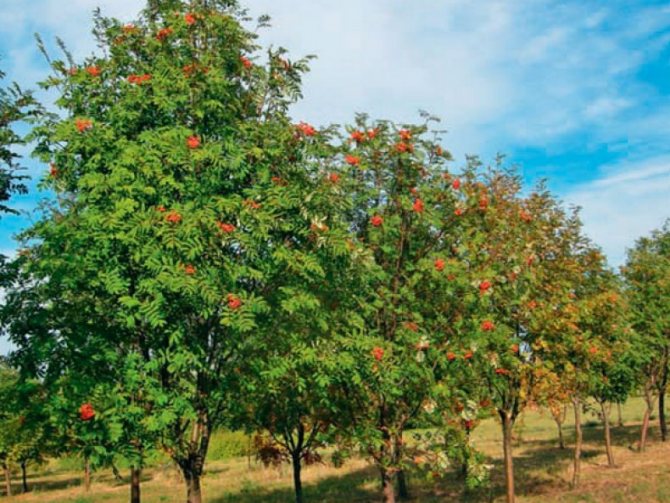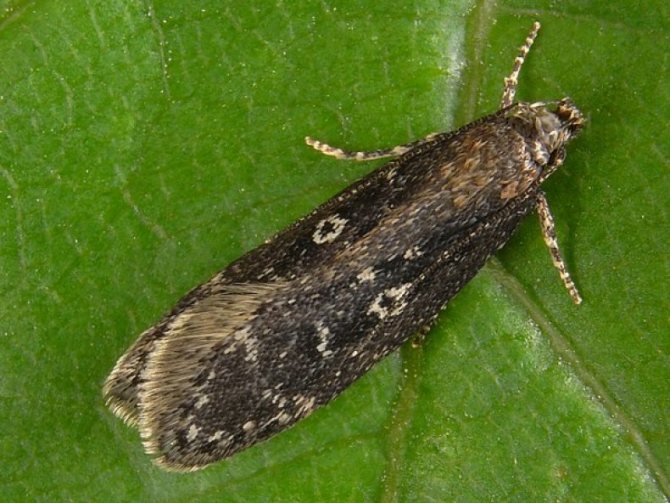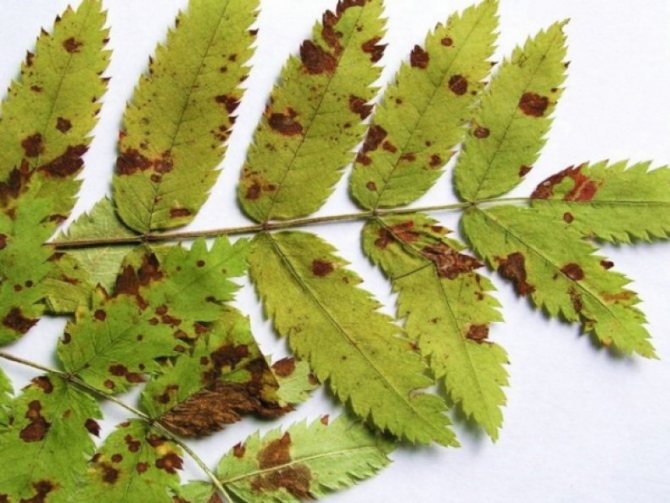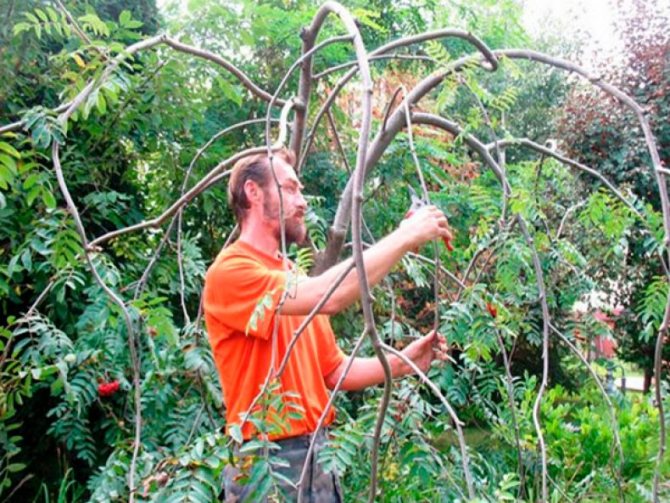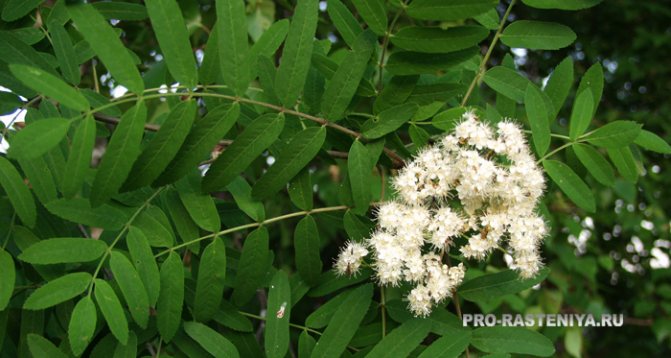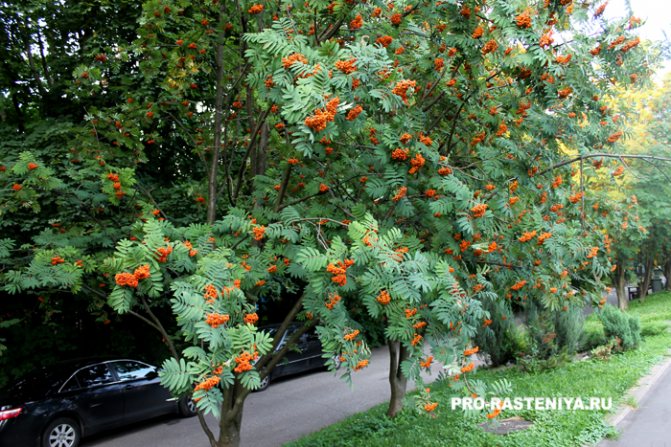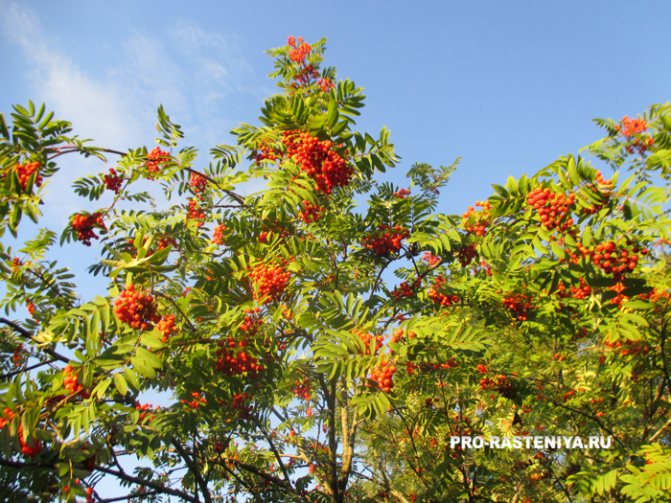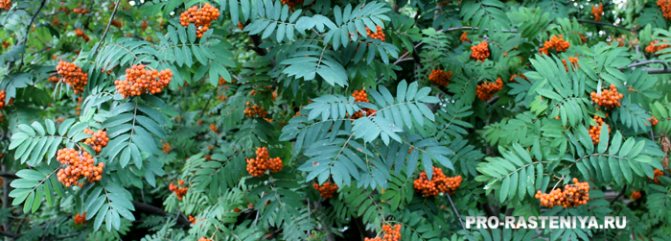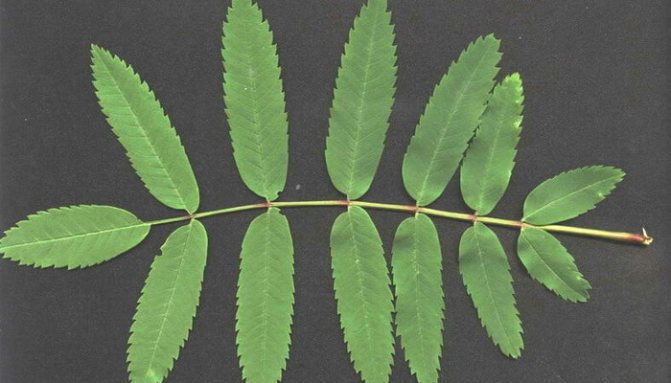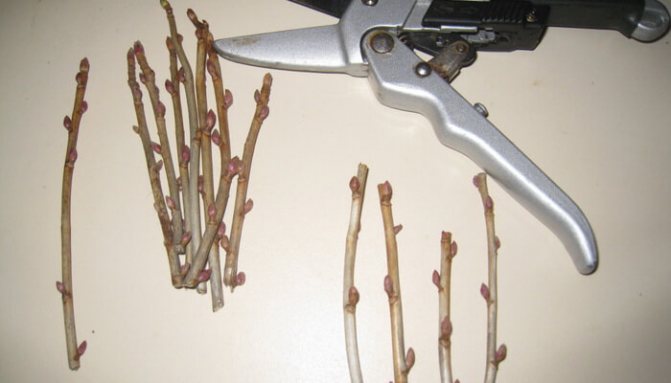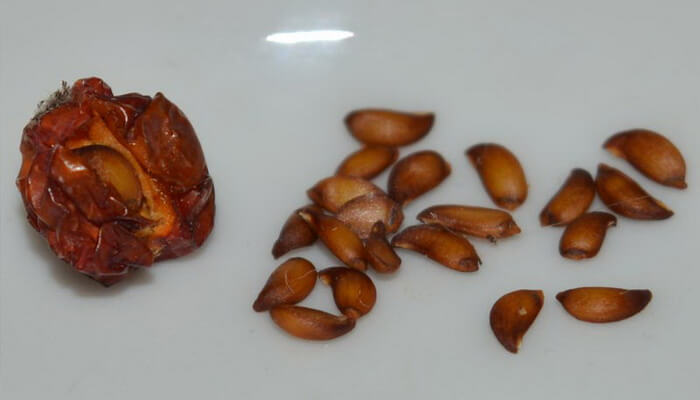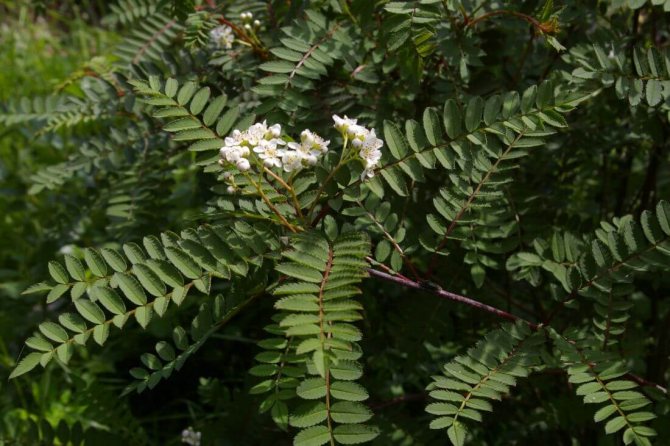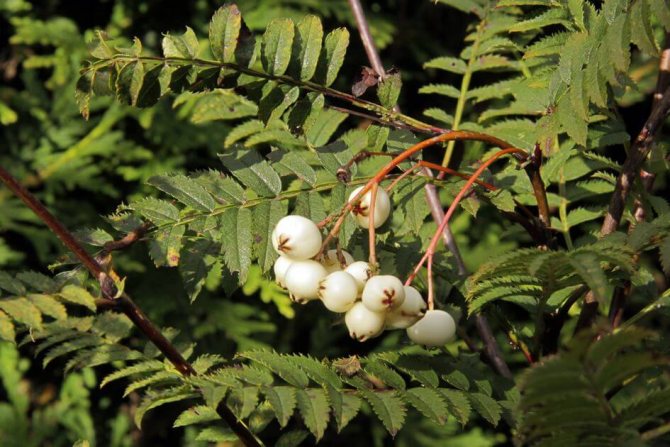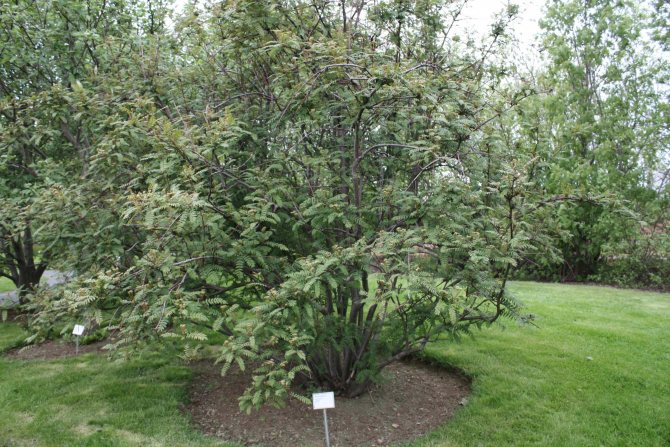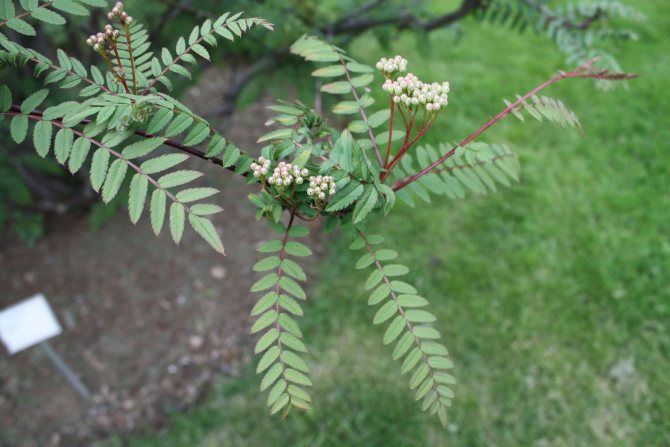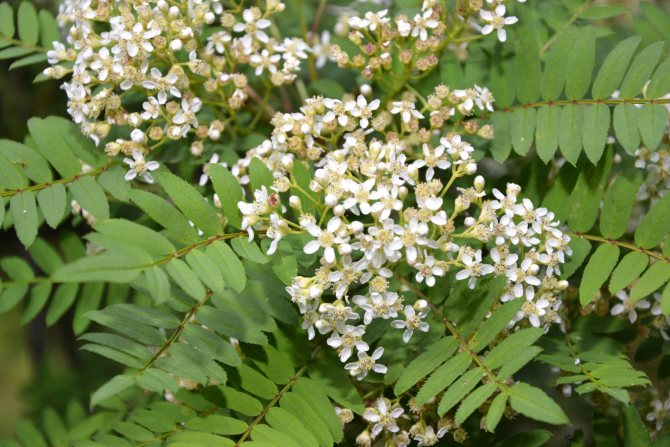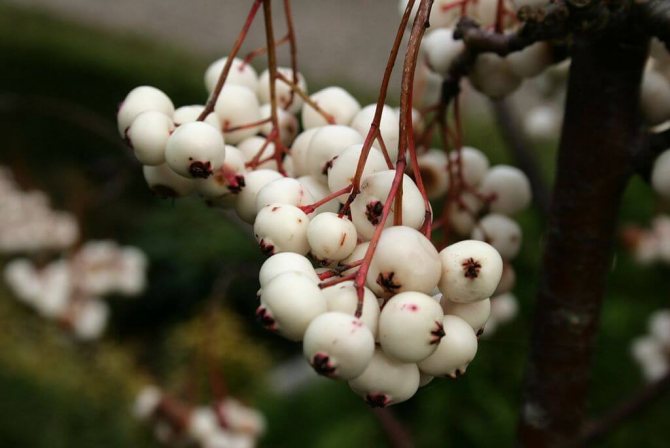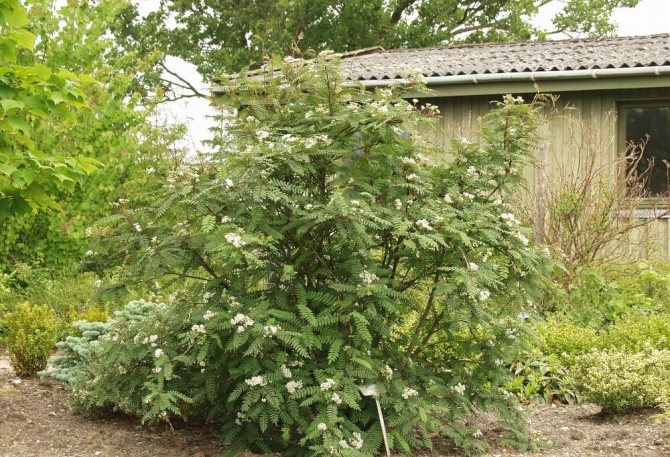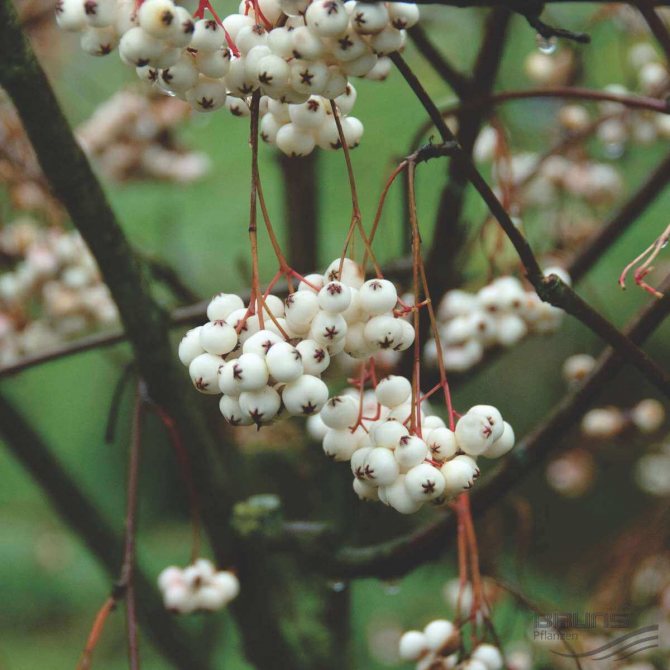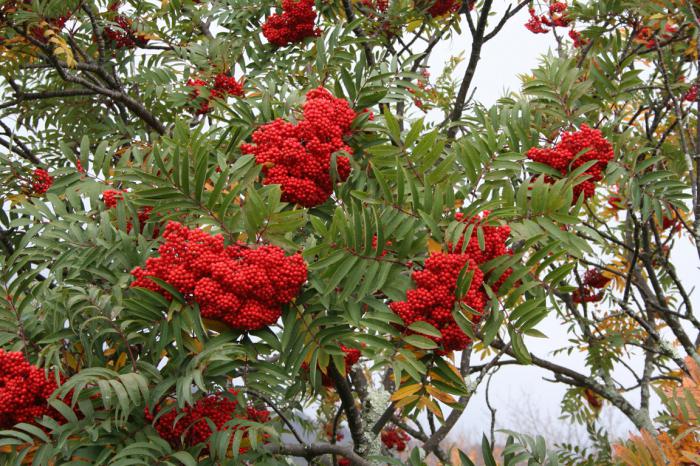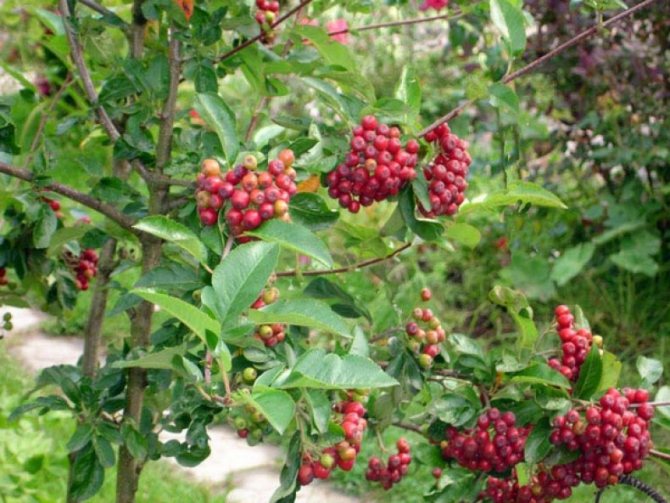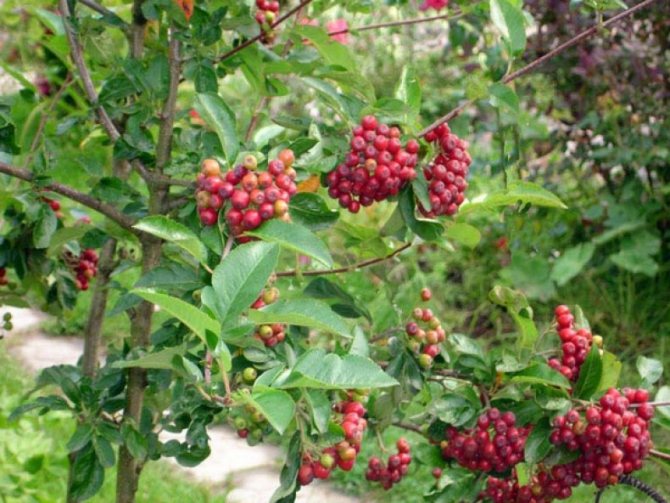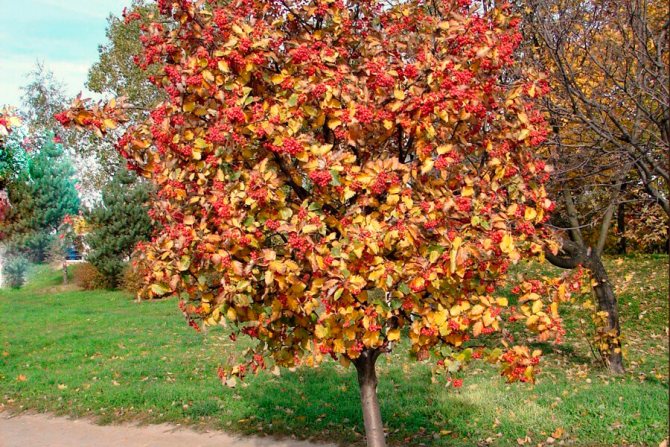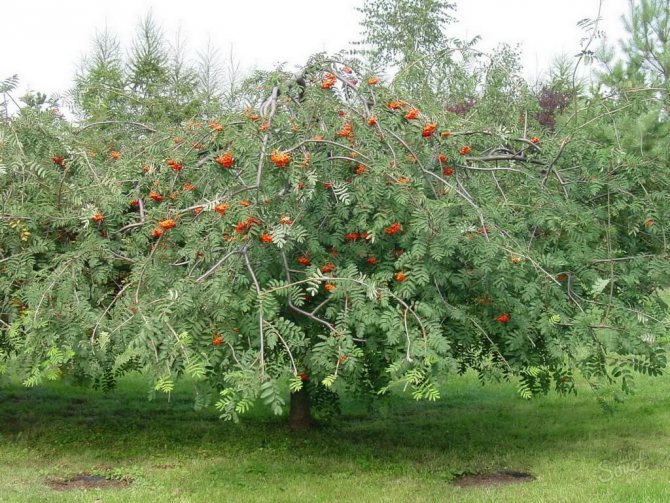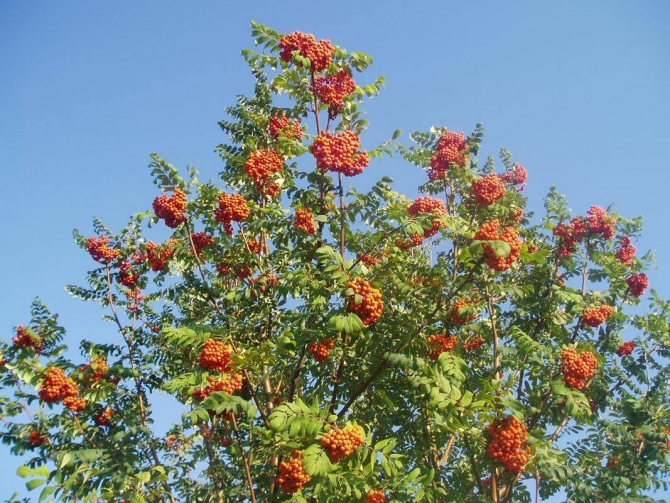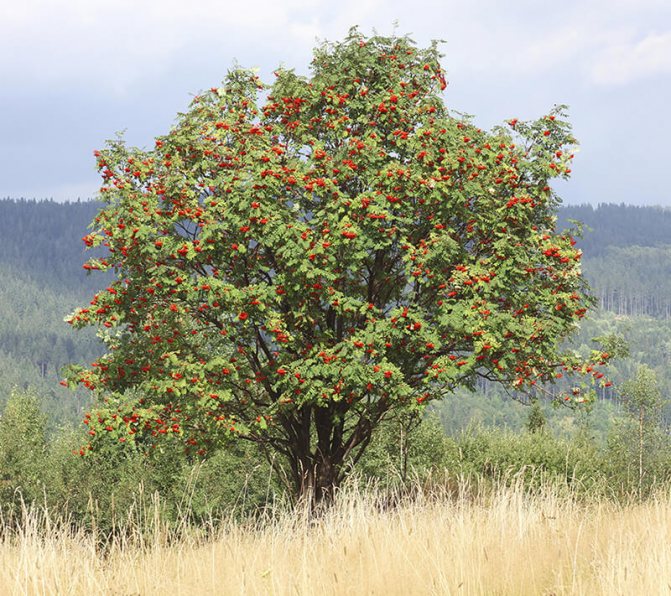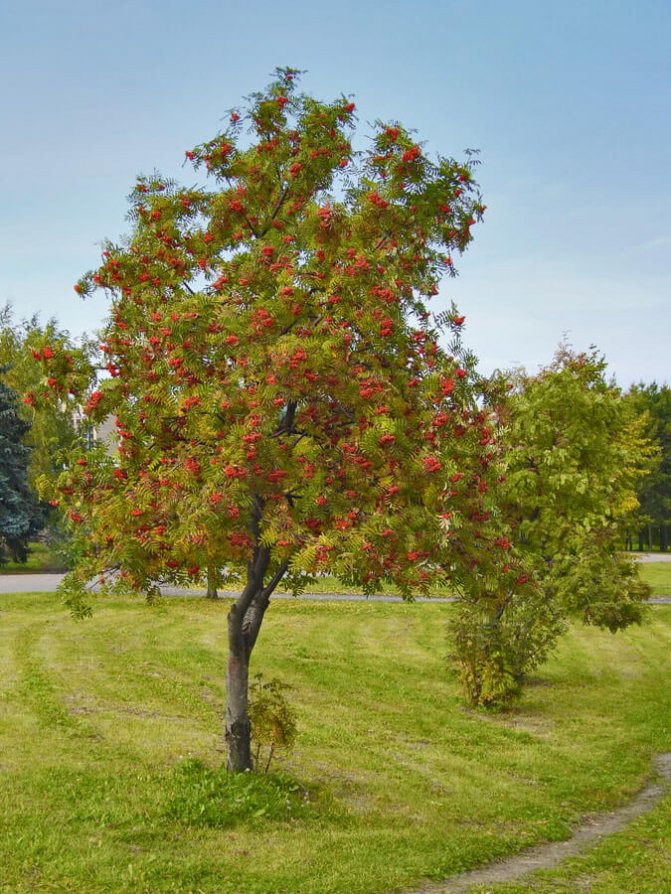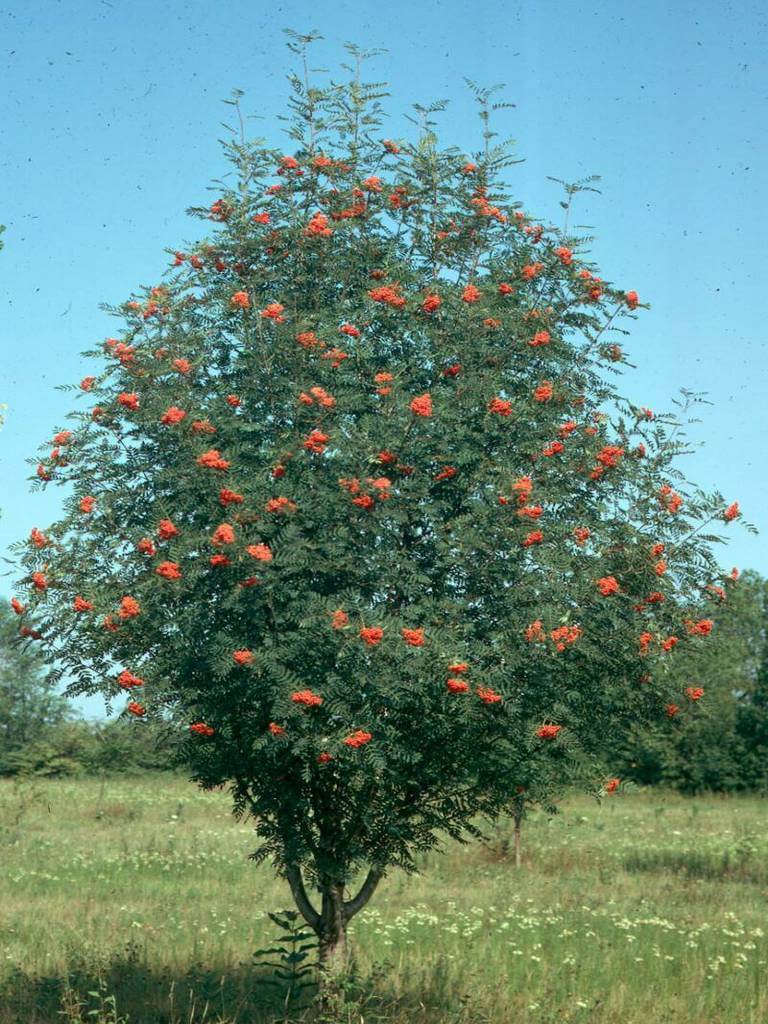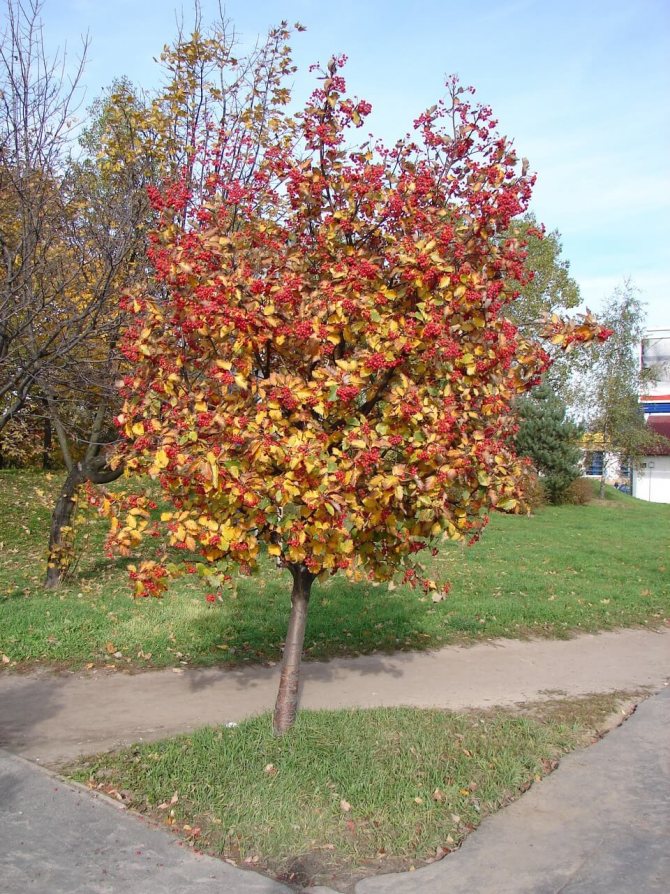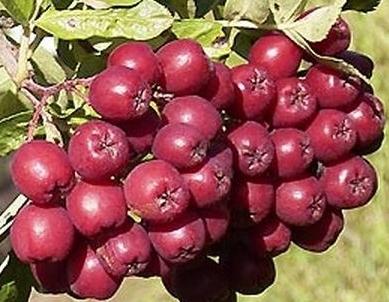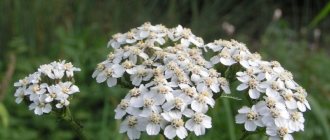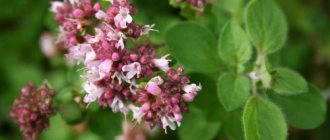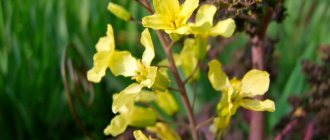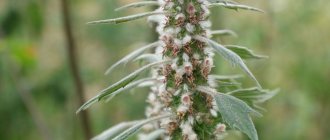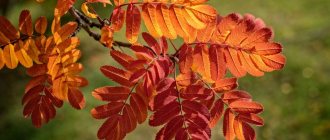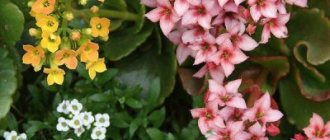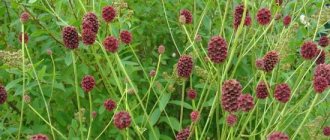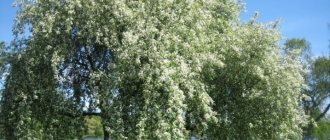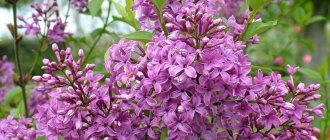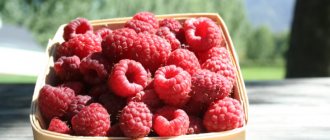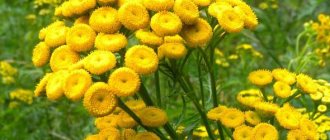In the old days, mountain ash was attributed to magical properties. The ancient Celts considered her to be a reliable protector from the evil eye and damage, all kinds of troubles.
Shoots and ripe fruits of mountain ash were used to decorate dwellings, used as a talisman; dried, soaked or boiled in honey berries were served, and powder from dried fruits was added to flour. Rowan is a northern culture, therefore it calmly tolerates a temperature drop to -50.
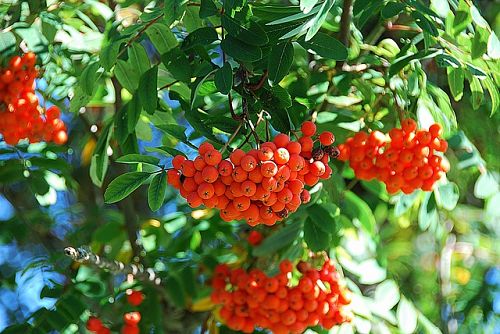
But along with high winter hardiness, the plant is quite demanding on the soil, grows poorly on dry soils, needs additional watering, loves illuminated places, and in the shade, growth and yield weaken.
Rowan care consists in the timely removal of shoots, which is often formed at the root collar, as well as watering, fertilizing and loosening the soil, forming the crown and fighting pests and diseases.
Rowan planting
It is planted in autumn or early spring - usually until the end of April, as it starts growing early. To get a more generous harvest, it is better to purchase several varieties of mountain ash: single-variety plantings, although they are prone to self-fertility, are still less productive.
The trees are planted at a distance of at least 4-6 m from each other. Pits are dug 60-80 cm deep and wide. They are filled with a mixture of compost soil with a fertile surface layer of soil, to which they add a handful of ash and superphosphate and 2-3 shovels of three-year manure humus (fresh, unripe manure burns the roots). After planting, rowan seedlings must be watered and shortened by the central conductor, and the next year - young and lateral shoots.
When to collect and how to store rowan berries
Rowan berries fully ripen in September-October. During this period, it is worth harvesting. The second option is to wait for the first frost, when the fruits become sweet. They should be removed from the tree along with the stalks. The berries collected in this way can keep fresh for a long time. You can use freezing to store rowan, but do not thaw. Or you can simply lay out the rowan fruits in a layer of 10-15 cm and keep it like that until spring at a temperature of 0-1 ° C.
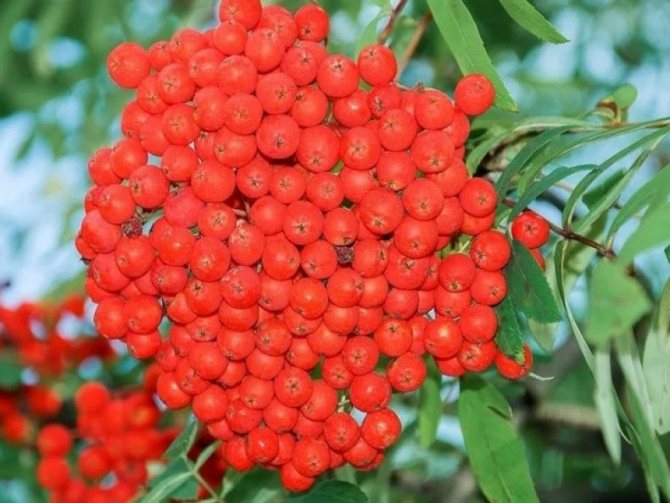

Rowan - a great option for a summer cottage. It is not only very picturesque, but also has a lot of useful properties. You just have to be convinced of this on your own experience.
Rowan care
Rowan care is reduced to the timely removal of shoots, which often forms at the root collar, and shoots growing below the grafting site, as well as watering, fertilizing and loosening the soil, forming the crown and combating pests and diseases. Since rowan trees start growing quite early and quickly in the spring, pruning and feeding of plantings should be carried out as early and as soon as possible. At the same time, weak and broken shoots are cut out from young plants, the longest are somewhat shortened to the outer bud.
When pruning fruiting plants, the nature of fruiting should be taken into account. In species and varieties of mountain ash, bearing fruit on the growths of last year, the shoots are only slightly shortened, and the thickened crown is thinned out. Plants with weak growth are given rejuvenating pruning for two to three years of wood in order to induce the growth of new shoots. In mountain ash, bearing fruit on various types of fruit formations, the semi-skeletal branches are shortened, systematically thinning and rejuvenating the ringlets.
Starting from the third year of life, young mountain ash must be fed with mineral fertilizers. Three-fold feeding is most effective: in the spring, before flowering, 20 g of nitrogen are added. 25 g of phosphorus and 15 g of potash fertilizers per sq. m landings; in summer - 10-15 g of nitrogen and phosphorus and 10 g of potash; in the autumn, after harvest, - 10 g of phosphorus and potassium. Fertilizers are embedded shallowly, slightly digging up the soil, after which the plantings are watered abundantly.
Rowan inflorescence. <>
Rowan ordinary: growing and care
Rowan is very beautiful both during flowering and with bunches ripe on the branches. The berries on the tree last for a long time, they are not afraid of frost, they are tasty in the form of juices, jellies, jams, marmalades, pastilles or simply rubbed with sugar. You can even make homemade medicine based on them. Therefore, many gardeners are interested in having at least one rowan tree on their site. She is a classic of the Russian landscape. And the ancient Slavs attributed to the mountain ash the ability to protect the courtyard from all evil spirits.
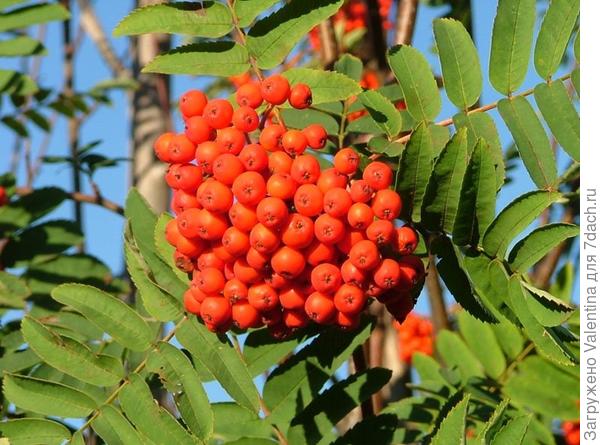

Planting and growing common mountain ash.
It is possible to grow ordinary mountain ash on the most ordinary soil, but on the lungs the tree will grow worse and give a lower yield than it could. It is most favorable to plant rowan in the fall. A planting pit 60x60 cm in size is filled with fertile soil, about 5 kg of peat soil or humus, 100 g of potash fertilizer and 200 g of superphosphate are added to it. The easiest and quickest way to get a seedling is to graft a bud or stalk onto a seedling of any kind of mountain ash. This can also be done with the help of layering, grafting, seeds and root suckers.
You can grow mountain ash from freshly picked berries, which are harvested when they start to turn brown. They need to be freed from the pulp. Seeds should be kept moist until sowing in the fall. Shallow grooves are made in the soil, they are sealed with humus, deepening by one and a half centimeters. Plant in a well-lit area. When the seedlings grow up, transplant them to a permanent place. In the process of leaving, form a stem up to 80 cm in height and graft a couple of cuttings into its upper part, from which you will subsequently form a crown. According to the technique, rowan grafting is done in the same way as on an apple tree.
Rowan care, crown formation and pruning.
After that, all care comes down to weeding the weeds in time, removing the rootstock, applying fertilizers, watering and loosening the soil. It would also be nice to mulch the trunk circle (cover it with straw, pine needles, dried grass). Before the start of fruiting, a puddle should form in the near-stem circle from watering - this is the advice of experienced summer residents. Layers are made if the mother tree has a low-standard shape, which will allow you to easily bend the branches to the ground. In grafted plants, fruits will appear in 2-4 years. It is advisable to plant or plant a couple of varieties at least so that they are cross-pollinated. Pruning is done to evenly illuminate the tree, hence for a larger yield. Since the crown of the mountain ash is pyramidal, and the branches from the trunk depart at an acute angle, this has a bad effect on their strength. Therefore, when forming the main skeletal branches, try to bring them out at an obtuse or right angle.
Pruning is done in early spring before the buds swell. In young trees, shoots are weakly shortened to the outer bud, shoots that branch off at an acute angle and excess are removed. Varieties that bear fruit on last year's growths are thinned out and slightly shortened. If the growth is weak, rejuvenating pruning for two or five years of wood will help. The rowan tree, on which several varieties are grafted, are shortened by semi-skeletal branches and in the most productive years, ringlets (the smallest branches) are thinned out. Rowan shoots grow quite quickly, almost everything ripens by winter.
Red rowan varieties
There are many varieties of red rowan, but at home, sweet-fruited species are more interesting for growing:
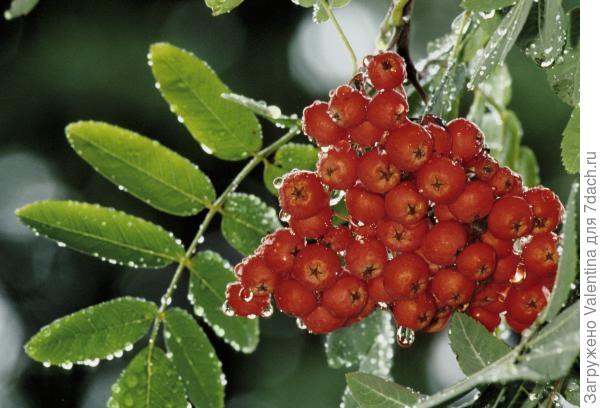

Russian variety or liqueur bred by Michurin - he crossed an ordinary forest mountain ash with a black chokeberry. Possesses high winter hardiness and productivity. Large fruits up to 15 mm in diameter, almost black. It is mainly used for the preparation of liqueurs, liqueurs and preserves.
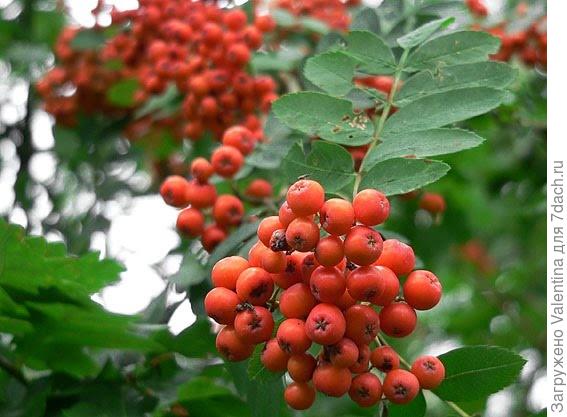

Rowan home very common throughout Central Asia, grows in the Crimea. Differs in very large green size with plum fruits. The tree is very tall - almost 15 m in height.
Variety Nevezhinskaya. The tree is up to 10 m high with a wide pyramidal crown, strong. It has dark gray branches and trunk, which darken with age. She has oblong-pointed large buds and elongated, red 5-sided fruits. The taste is good, the bitterness is not felt. Ripens in August-September.
Variety Pomegranate. Obtained by crossing rowan with hawthorn. The height of the tree is up to 4 m. It has a very thin crown. Faceted pomegranate-colored fruits have a slightly tart sweet taste and become ripe in August-September.
Titanium grade. Received in 1916 by I.V. Michurin. He pollinated a hybrid rowan seedling with pollen of various varieties of apple trees and pears. The tree is tall, almost 10 m tall with a dense pyramidal crown. Faceted red, juicy fruits. The taste is sweet and sour. High-yielding winter-hardy variety.
Ruby variety. Obtained as a result of pollination of mountain ash with pear pollen of different varieties. Fruits sweet and sour faceted, dark red.
Read also: When and how and how to plant dahlias in the spring in open ground
Most varieties of mountain ash are self-fertile, therefore, for a good harvest, it is advisable to plant several different varieties for cross-pollination. You can negotiate with neighbors and plant trees of different varieties on both sides of the fence. If you are only planting one tree, plant a couple of other varieties in the crown.
Harvesting


Rowan berries on the branches last for a long time. It is better to harvest from bitter-fruited varieties after the first frost, so that the astringency goes away. Berries of sweet varieties are removed immediately when ripe, so that birds do not peck them. You can pick off low-growing trees with your hands, and cut off brushes from high ones with loppers. If the berries are removed after frost, then they can be stored all winter in brushes in a cold place or frozen. And the fruits collected before frost must be cleaned of leaves, branches and stalks, sorted out, dried in the air and dried in the sun or in the oven. About 20 kg of fruits are usually harvested from one tree.
Reproduction of mountain ash
Species mountain ash - by seeds, and decorative forms and varieties - by grafting on mountain ash or Finnish mountain ash, since the latter has a more powerful and deep root system and plants grafted on it suffer less from dry soil. Good results can be obtained by using common hawthorn as a stock. Rowan peeling is usually carried out in July - early August with a sleeping eye. Rowan home (Sorbus domestica) fails on ordinary rootstocks; it grows well only when grafted on wild pears.
When mountain ash is propagated by seeds, sowing is carried out in autumn or spring, about 150 seeds are sown with seeds stratified from autumn per 1 running meter. Dried or last year's seeds are pre-soaked for 3-4 hours before stratification. Crops carried out before winter must be insulated with leaf litter. Seedlings of most types of mountain ash grow quickly and by autumn they are suitable for planting in school for growing and forming.
The technology of growing planting material from rowan seeds is much simpler, and in some cases more convenient than propagation by grafting - a sleeping bud or cuttings.However, during seed reproduction, one should take into account not only the degree of variability of species, but also the later entry into the season of flowering and fruiting of young plants.
A number of mountain ash, for example, Finnish, elderberry. large-fruited, Moravian, sweet-fruited, Nevezhinskaya, Burka and some others, with seed reproduction, give offspring that practically does not differ from the maternal forms and is not inferior to plants obtained by grafting.
Shoots of mountain ash grow rather quickly and, as a rule, ripen. It is best to plant young plants in a permanent place in the fall, leaving 3-4 m between vigorous species, and 1.5-2 m between small ones.
How to plant rowan - important rules
In order for the autumn planting to be successful and the mountain ash to take root in a new place, experienced gardeners recommend adhering to several basic rules:
- The planting material must be in perfect condition, if the roots begin to curl, then such a tree will take root worse and must be planted before the cold weather.
- If the seedling was purchased with a closed root system or a special net, then you do not need to get rid of them.
- If you miss the timing of the autumn planting, it is better to postpone the procedure to the spring.
- Do not overdo it with the amount of fertilizer applied.
You can not use manure as a top dressing, it can burn and damage the young root system.
- A small tree needs to be prepared for cold weather.
- It is advisable to tie the rowan planted in the fall to a support so that it does not sway and break during a strong wind.
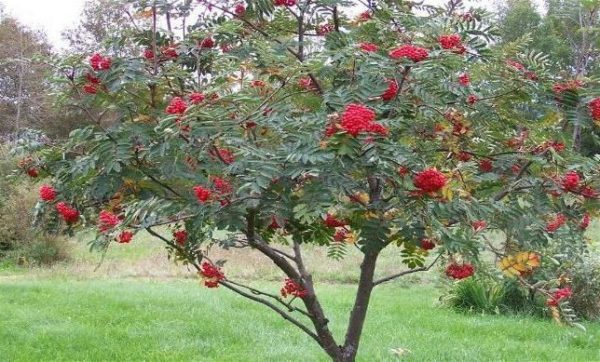

Correctly planted rowan
Rowan varieties
Everyone knows the rowan, but many varieties with tasty and healthy fruits have been bred on its basis, many do not suspect.
- ‘Scarlet large’ - one of the most valuable varieties of this crop. During hybridization, a mixture of pollen from different pear species was used. Its fruits are very large (over 4 g), scarlet-red, reminiscent of cherries, juicy, with a slight astringency, but without bitterness. The variety is fast-growing, universal. The yield from one adult tree reaches 150 kg.
- 'Bead' - bears fruit in the 4-5th year after planting. On a short tree, ruby-red fruits ripen with a taste reminiscent of cranberries. The variety is winter-hardy, disease resistant. The yields are stable.
- ‘Wefed’ - received from Nevezhinskaya mountain ash. A short tree bears fruit stably. Fruits are orange-pink, shiny, weighing up to 1.3 g. The variety is characterized by high winter hardiness.
- ‘Pomegranate’ - a hybrid of common mountain ash with large-fruited hawthorn. The height of the tree is 3-4 m. Fruits are the size of a cherry. The taste is sweet and sour, without bitterness. Winter hardiness and productivity are high. Fruiting from the age of three.
- 'Beauty' - the result of crossing rowan and pear. The tree forms a wide pyramidal crown, its height is 5–6 m. Fruits abundantly and annually, the fruits are large, 1.8–2.2 g, rich orange-red color with an oblong shape uncharacteristic of mountain ash. The taste is somewhat tart.
- 'Hope' - the tree is undersized. Fruits (1.8–2 g) contain a large amount of biologically active substances. The variety is distinguished by its early maturity and high yield.
- 'Ruby' - a dwarf plant (2–2.3 m) with a spreading crown. Fruits are dark ruby (1.8 g), pleasant sweet and sour taste.
- 'Titanium' - the variety is obtained by crossing the mountain ash with a pear and a red-leaved apple tree. It is a medium-sized tree with a wide, rounded crown. Fruits are dark red with a bluish bloom weighing up to 2 g. Very winter-hardy. Bears fruit annually.
- ‘Sorbinka’ - medium-sized tree. The fruits are large (up to 3 g), yellow-red, with a pleasant refreshing taste. Bears fruit in the 5-6th year. The crops are plentiful.
Rowan berries.
How to choose healthy rowan seedlings when buying
When choosing rowan seedlings, pay attention first of all to the roots, they must be strong and healthy, have 2-3 main branches (at least 25-30 cm long). The surface of the roots should be fresh and damp.With weathered and dry roots, even if the seedling takes root, it will grow slowly.
Pear, cherry, apricot, hawthorn, almond, irga, medlar, plum, peach, strawberry and raspberry, as well as mountain ash, belong to the pink family.
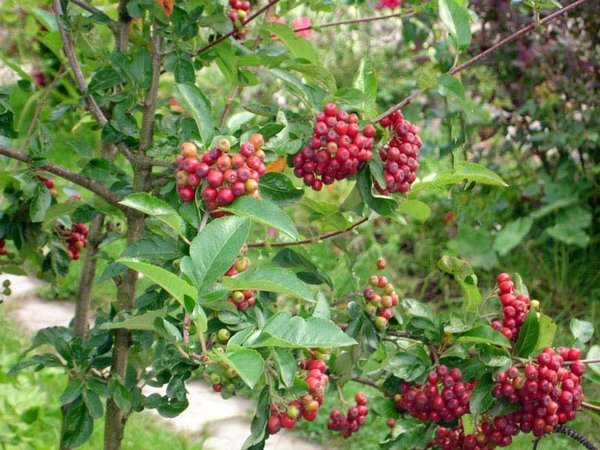

The shriveled bark of the trunk and branches of the seedlings indicates that they were dug up a long time ago and they have already dried out. If, after you have pinched off a little bark, you see not a green bottom, but a brown one, such a seedling is already dead and not suitable for planting. For transportation, place the roots of the seedling in a plastic bag, after wrapping them in a damp cloth.
Did you know? The Latin name for mountain ash is aucupаria. Consists of two words: avis, meaning a bird, and capere, to catch, attract. Given to the plant due to the attractiveness of its fruits for birds, they were used as bait when catching birds. This feature is very useful, since birds help to protect fruit and berry plantations on the site from pests.
Diseases and pests of mountain ash
Rowan is quite well resistant to various pests and diseases. Significant damage is noted only in some years. On the mountain ash tree there are such pests as sawflies, scoop caterpillars, and ticks. On the flowers of the tree, flower beetles settle, and on the fruits and branches of the mountain ash moth, apple fruit sawfly and bark beetles. The rowan harvest is significantly reduced by birds.
Poetised by the people and shrouded in legends about the magical properties of the common mountain ash is widespread everywhere. It is believed that mountain ash should be planted near the courtyard as a bright accent of the garden composition and a component of the classic Russian landscape. Due to its catchy alongside, red rowan is an indispensable element of lush ensembles of white birches, other decorative deciduous or low conifers. She is also picturesque as a soloist. The fruits are used in cooking, but more often they become a saving natural barn for wintering birds.
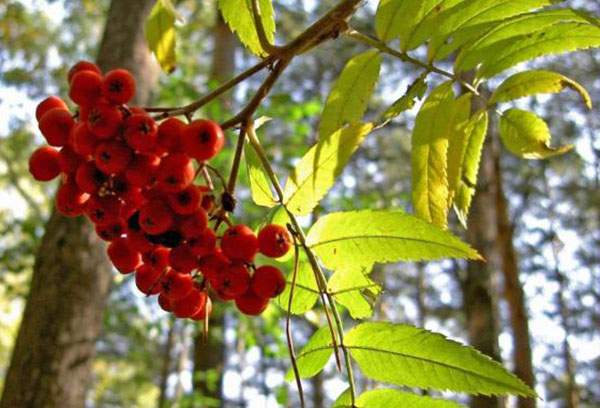

Rowan varieties
In nature, there are about eighty species of mountain ash trees. Each of them grows in specific climatic conditions.
The most popular varieties:
- mountain ash red (ordinary);
- mountain ash alder;
- Tibetan;
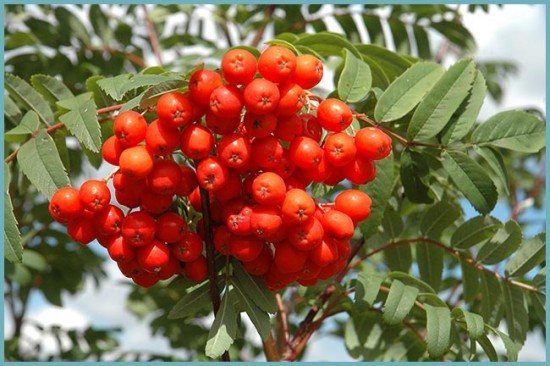

- Kashmirian;
- mixed;
- rowan aria.
Rowan varieties:
16 excellent varieties of plums for the Moscow region
- Russian;
- Home;
- Nevezhinskaya;
- pomegranate;
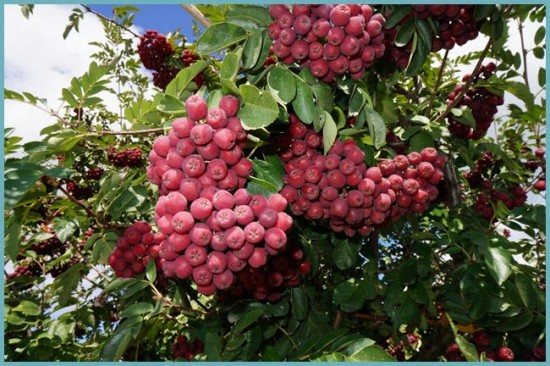

- titanium;
- ruby.
In our latitudes, the common mountain ash (red) is most often found. Its maximum height is 17-18 m, the depth of the root system is up to 2 meters. Read about the methods of planting chokeberry and its beneficial properties here.
Description
Rowan is a frost-resistant shade-tolerant tree or shrub of the Rosaceae family, it grows up to 10 m, the crown width reaches 6 m. The root system is powerful, penetrates deep into the soil. The rowan has been living for over a hundred years. The tree is decorated with complex-elongated leathery leaves, which consist of small pointed leaves: bright green in summer, yellow-crimson in autumn. In late spring, the tree is adorned with bouquets of fragrant pink-white or cream flowers. And from the middle of summer to the end of winter - orange-red bunches of berries. The fruits are astringent, sweet and sour, with a bitter aftertaste, rich in vitamins and microelements.
The berries are harvested in August and September. Jam, jams, various desserts are prepared from the fruits. Rowan is widely used as a medicinal plant.
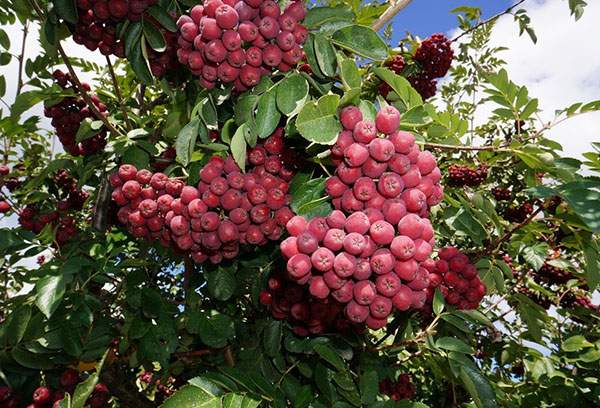

The best tips for the care and planting of red mountain ash
Rowan ordinary (red) is a type of mountain ash, belonging to the family pink, the height of this fruit tree is 5-12 meters, long green dull leaves, consisting of 7-15 leaves, grow up to 20 cm, large white inflorescences exude an unpleasant odor, and orange-red, juicy fruits, ripening in August-September, hang on the branches before winter.It is known as a vigorous, durable, frost- and drought-resistant, popular medicinal (containing vitamins, trace elements, carotene, organic acids), ornamental plant, which is not very demanding for growing conditions. Let's figure out how to properly organize red rowan planting and care at their summer cottage.
Reproduction
Rowan is propagated in several ways: by seeds, grafting, shoots, layering. Each method has features to consider.
- Trees with unpredictable qualities grow from seeds, which begin to bloom and bear fruit later.
- Trees that repeat the properties of the parent form are grown with seeds of such species and varieties as Burka, Nevezhinskaya, Moravian, Finnish, elderberry and some others.
- Mountain ash obtained by crossing is propagated by grafting. They are grafted onto an ordinary mountain ash or hawthorn. The best stock for home rowan is wild pear.
Finnish mountain ash is a favorable material for grafting: it has a powerful root system that penetrates deep into the ground.
Sowing seeds
You can independently prepare seed from the berries.
- Until autumn, the seeds extracted from the berries should be in a moist substrate.
- If the seeds are sown in spring, they are soaked for several hours.
- For sowing red rowan seeds, choose a sunny place.
- Grooves are made in the soil, sprinkled with humus on top, the seeds are buried 1.5 cm.
- Autumn crops are covered with a layer of leaves.
- The next year, the seedlings are transplanted.
After two to three years, a stem is formed from young trees at a height of 80 cm and cuttings of the varieties you like are grafted.
Transplanting wild shoots
If they take the material for the stock from the forest, the trees are dug deep, because the mountain ash has a well-developed root system. A year later, when the tree takes root, several cuttings are grafted onto it. For efficiency, cuttings of more than one variety are taken.
Advice
You should always carefully remove the shoots from the roots of the mountain ash, on which the grafted cuttings take root. Otherwise, the shoots will take all the nutrients, and the cuttings will die.
Sapling requirements
Young trees should be of high quality: fresh, with good, not dry roots. Buy 1–2 year old seedlings with the following characteristics:
- 3-4 branches up to 20-30 cm long extend from the central root;
- the bark is even, smooth, without damage;
- there is a conductor and several branches.
Seedlings are transported wrapped in damp cloth or polyethylene.
Advice
If the planting of mountain ash is not only for a decorative purpose, but you want to feast on fresh vitamin products, they buy different varieties for more effective pollination.
Preparing the site and pit for planting
Before planting a young tree in the ground, a set of preparatory work is performed. It includes:
- digging holes (they are dug at a distance of 5-6 m from each other, the depth of each hole cannot be less than 60 cm, and the width - 80 cm);
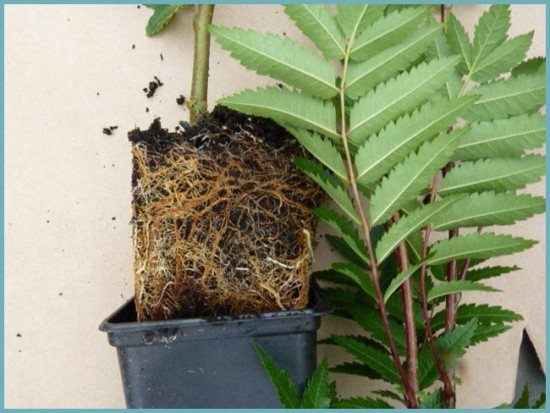

- soil preparation for each of the trees;
- planting crops in the ground.
For each of the depressions, a nutrient soil must be prepared. It includes:
- compost soil;
- wood ash;
- superphosphate fertilizer;
- humus (not fresh, as it quickly burns young roots).
Tree planting technology:
Flower bed design. TOP 10 simple and effective techniques
At the bottom of the pit, drainage is laid out from pieces of broken brick, large rubble or expanded clay.
- Fill with prepared soil.
- Make a hole for planting a tree.
- Cover the root system with earth.
- Water the young seedling abundantly.
Seat selection
Tall varieties are placed around the perimeter of the site, otherwise the tree will shade other plants. Since mountain ash is winter-hardy, the northern side is often allocated for it.
The plant tolerates shade and sun equally well, loves wet areas, but the occurrence of groundwater should not exceed 1 m.
The best soil for mountain ash is a fertile loam that retains water for a long time, although the tree also grows on less nutritious soils. It develops poorly on alkaline soil, sandy loam must be fertilized. Acidic soils alkalize - you will need from 200 g to 1 kg of lime or dolomite flour.
Rowan red (ordinary) - a healer in the garden: how to grow, planting rules
Rowan red is a popular medicinal plant. Everyone - children and adults - knows about its miraculous healing properties. Scarlet fruits are actively used in folk medicine for the treatment and prevention of many diseases; various medicinal tinctures and decoctions are prepared from them. In order for the red rowan berries to always be at hand, you need to worry about planting a tree on your site. This article will help you choose a place for rooting a seedling, prepare a suitable soil for it, teach you how to properly care for it and fertilize it.
Read also: How to protect your garden and vegetable garden from frost
Landing
Young trees planted in autumn do better. In the spring, planting is carried out in April, because the mountain ash begins its growing season early.
- Before planting, the leaves are removed, the damaged branches and roots are cut off, the seedling is placed in a clay mash for several hours.
- When planting red rowan in spring, the seedlings are soaked in water for 48 hours.
- A planting hole is dug in dimensions of 0.6 x 0.6 x 0.4 m, retreating from other trees 4-6 m.
- The removed topsoil is mixed with 5-6 kg of compost or humus, 100 g of superphosphate, 25 g of potassium sulfate or 300 g of wood ash.
- Pour in water, then place a seedling and pegs in the middle to support it.
- Covering the hole with earth, make sure that the root collar of the seedling rises 5 cm above the soil.
- The stem is cut from the top by 20-25 cm; ...
- The soil is compacted, watered and mulched.
Dates of autumn planting
The autumn planting time is determined by the climate of the area where the mountain ash will grow:
- In the central region, the best period will be mid-September - mid-October.
- In southern latitudes, it is best to plant rowan from early October to early November.
- In the northern regions, the entire September - early October will be an acceptable period.
- For Siberia and the Urals, autumn planting is most suitable, because spring in these areas is not stable, there is a risk of frost or, on the contrary, extreme heat. At the same time, autumn runs with a comfortable temperature regime and sufficient rainfall.
Rowan, like other trees, is recommended to be planted after leaf fall.
If the planting dates were missed, then the seedling must be saved until spring. In this case, use one of the three existing methods:
- Basement storage:
- The roots of the seedling are dipped into a container with wet peat, sand and sawdust.
- The room should have comfortable conditions (air temperature from 0 to +10 degrees and 85-90% humidity)
- Once a week, the root system is additionally moistened.
- Digging in:
- A deep hole is dug on the site and the roots of the seedling are placed there at an angle of 45 degrees.
- Then it is buried using a moistened mixture of sand and peat.
- Snowing:
- The seedling must be wrapped with a damp cloth and buried in this state in the snow. In this case, the optimum temperature for it will be maintained.
Using the latter method, you need to ensure that the seedling does not bare, and the layer of snow always remains thick.
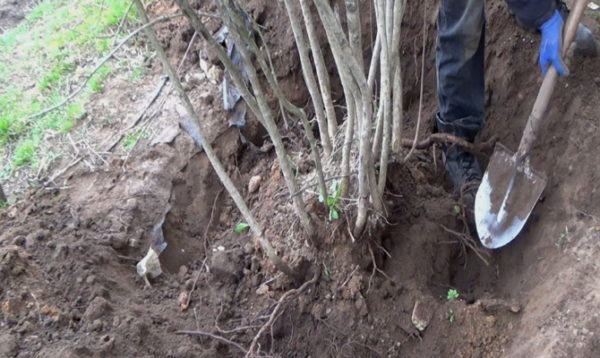

Preparing rowan for planting
Young rowan care
After planting, the seedlings are carefully looked after.
- Pruning is done before sap flow. The damaged branches are removed and those that have grown the longest are shortened to the outer bud.
- Water abundantly - 20-30 liters per tree. Up to 4 irrigations are carried out per season, if there was not enough natural precipitation. The soil is then covered with mulch. To properly water a tree, you need to pour water into the grooves dug along the diameter of the crown.
- The soil is cleared of weeds.
- Before frosts, the trunk is insulated with dense agrofibre, spruce branches. Snow is being thrown down.
If fertilizers are used during planting, the mountain ash is fed only in the second year, in the spring, by adding nitrogen means to stimulate the development of the tree. In the third year after planting, the mountain ash is fed three times, sprinkling the soil under the crown with preparations. Then the soil is dug up and watered.
- Before flowering, mountain ash is supported with such fertilizers: 20-25 g of nitrogen and phosphorus, 15 g of potassium preparations per 1 sq. m.
- In July - 10-15 g of phosphorus and nitrogen fertilizers, 10 g of potash.
- At the end of August, potash and phosphorus agents are introduced - 10 g each.
How to prepare red rowan for winter
A newly planted tree will not have time to fully grow stronger before the onset of cold weather, so it needs help to cope and survive the cold weather. To do this, the gardener must follow these steps:
- Rowan trunk is wrapped in burlap, after which the structure is insulated with spruce branches.
- The lower part of the trunk needs additional protection, so it needs to be buried with fallen snow and make sure that its amount does not decrease and does not expose vulnerable areas.
- For, to avoid sunburn, the rowan trunk must be whitewashed.
- Protection from rodents can be provided by special pesticides that are scattered around the tree.
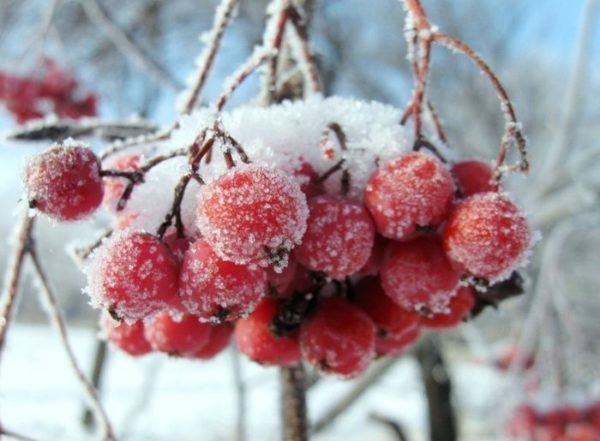

Rowan berries left for the winter not picked
How to care for a mature tree?
Rowan trees, which were grafted with cuttings from different varieties, begin to bear fruit as early as 2-4 years after planting. Caring for rowan ordinary provides for regular watering during a drought at the rate of 10 liters of water per 1 sq. m crown projection. After watering, the soil should be mulched. Shoots that grow below the root collar are regularly removed. Moreover, the shoots must be cut low, without hemp. If the tree is grafted, cut off the shoots that grow below the graft site.
The rowan tree itself forms a pyramidal crown from branches growing at an acute angle. Therefore, regular pruning prevents thickening and increases the illumination of the crown. Only those branches are left that depart from the central conductor at an angle of 45 degrees or more. Sanitary pruning is carried out in autumn and spring.
The trees are quite resistant to diseases and pests. Rowan leaves and bark are damaged by moths, scoop caterpillars, sawflies, ticks, against which conventional insecticides are used.
Rowan is smoke-resistant and is widely used in landscaping. Its delicate leaves and bright bunches add a touch of lyricism to the cityscape.
Rowan red is a popular medicinal plant. Everyone - children and adults - knows about its miraculous healing properties. Scarlet fruits are actively used in folk medicine for the treatment and prevention of many diseases; various medicinal tinctures and decoctions are prepared from them. In order for the red rowan berries to always be at hand, you need to worry about planting a tree on your site. This article will help you choose a place for rooting a seedling, prepare a suitable soil for it, teach you how to properly care for it and fertilize it.
Rowan varieties
In nature, there are about eighty species of mountain ash trees. Each of them grows in specific climatic conditions.
The most popular varieties:
- mountain ash red (ordinary);
- mountain ash alder;
- Tibetan;
Red rowan fruits
- Kashmir;
- mixed;
- rowan aria.
Rowan varieties:
- Russian;
- Home;
- Nevezhinskaya;
- pomegranate;
Rowan Pomegranate
- titanium;
- ruby.
In our latitudes, the common mountain ash (red) is most often found. Its maximum height is 17-18 m, the depth of the root system is up to 2 meters. Read about the methods of planting chokeberry and its beneficial properties here.
Choosing a place for a tree, a suitable period for planting
For planting rowan ordinary, it is best to choose a place that is located at the edge of the land.In this case, the tree will not grow in the shade, which is very good for its life, and will not cover vegetable beds with its crown.
Important! Trees tolerate cold very well, they are not afraid of even severe frosts.
Autumn is the best time to plant a tree outdoors. The earth has not yet cooled down, so the plant will quickly adapt to the new conditions of its existence. Until spring, it will have time to take root, and then it will actively grow and develop.
Preparing the site and pit for planting
Before planting a young tree in the ground, a set of preparatory work is performed. It includes:
- digging holes (they are dug at a distance of 5-6 m from each other, the depth of each hole cannot be less than 60 cm, and the width - 80 cm);
Red mountain ash sapling
- soil preparation for each of the trees;
- planting crops in the ground.
Important! In order for the plant to accurately take root in the selected area, experts recommend planting several specimens of various varieties at once.
For each of the depressions, a nutrient soil must be prepared. It includes:
- compost soil;
- wood ash;
- superphosphate fertilizer;
- humus (not fresh, as it quickly burns young roots).
Tree planting technology:
At the bottom of the pit, drainage is laid out from pieces of broken brick, large rubble or expanded clay.
- Fill with prepared soil.
- Make a hole for planting a tree.
- Cover the root system with earth.
- Water the young seedling abundantly.
Taking care of the medicinal tree
The process of caring for mountain ash red is not as complicated as it might seem at first glance. It includes:
- Watering the seedling (it should be done regularly, its frequency directly depends on the season).
- Fertilizing the plant.
- Cutting broken branches, removing overgrowth on the trunk.
- Loosening the soil near the root collar of a mountain ash tree.
- Treatment of wood with special means against pests and diseases.
Rowan care is simple: watering, pruning, feeding
Fertilization and feeding of red mountain ash
To feed mountain ash trees, purchased fertilizers or infusions from dung or mullein are used.
If the finished products do not require preparation, but only compliance with the technology of their introduction into the soil, then a little time needs to be spent on the creation of a biovitamin substance.
Important! Experts recommend feeding the plant in the third year of its life.
Preparation of natural dressing:
- From bird droppings: fresh bird droppings are poured with water, the mixture is kept for 3-4 weeks, stirred well, water is added (ratio 1:10), poured under the root.
- From mullein: cow cakes, as well as bird droppings, are poured with a small amount of water, infused for 3-4 weeks, stirred with water (ratio 1: 5), poured under the root.
Organic dressings are very useful for mountain ash
Such vitamin supplements significantly activate the growth and development of mountain ash, they are carried out once a year.
Reproduction
Rowan reproduces in several ways, the most practiced of which are:
- fruit seeds;
- cuttings;
- vaccinations.
The easiest option is to multiply by seeds (this work does not require the application of a large amount of effort, as well as waste of time). Planting is done in early spring or autumn.
Red rowan seeds
Seed propagation technology:
- The seeds are pre-soaked in water (kept for 3-5 hours).
- The prepared seed is planted in the ground (at the rate of 150 pcs / 1 running meter).
- Water abundantly.
- Cover with dry foliage or straw (to prevent freezing).
- Young shoots are transplanted to another place for further growing.
Common diseases of red rowan
Birds are the biggest enemy for mountain ash fruits. It is very difficult to fight with them, since birds use berries for their feeding, especially in the cold season.
Among other pests, it is worth noting:
- caterpillar scoop;
- sawflies;
Sawfly larvae
- ticks;
- bark beetles;
- mole, etc.
Although the red mountain ash is practically not susceptible to diseases, it is pests that bring the greatest damage. They can be dealt with both by folk methods and by purchased chemicals.
Plant a red mountain ash on your site, you can check its benefits from personal experience!
Growing rowan: video
Correct planting of red rowan seedlings on the site
We will tell you how to plant mountain ash on the site so that it gives the best results.
Important! If you cannot immediately plant the purchased seedlings, then dig them in a shaded place for a while (up to 3-4 weeks). At an angle (to the south), make a shallow hole, place a seedling in it and cover the roots and shoots with earth half the length. Water liberally. If the plants are very dry, place them in water for a couple of days.
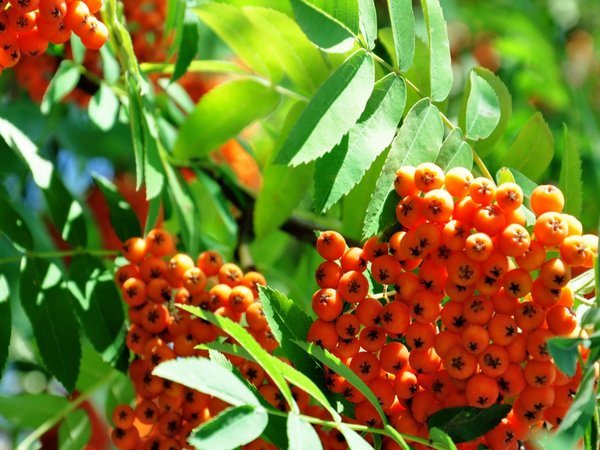

The best time to plant
Many people are interested in the question: when can you plant rowan? The answer is not straightforward. Planting is possible in early spring, but only until May, since the seedlings grow early and bear fruit later. Start as soon as the soil allows.
But it is still better to plant in the fall, a couple of weeks before the ground freezes. The soil is warmed up and has not yet had time to cool down, which will help the plants adapt faster, during the winter they will be able to take root, the soil around them will settle and compact well, and in the spring they will actively start growing.
Choosing a landing site
If you are wondering where it is better to plant rowan, then pay attention to the places at the edge of the site. So you will provide the plant with a non-shaded growing area (this will have a positive effect on its vital activity, since it is more light-requiring), and its crown will not shade other plants. Suitable as a wonderful background for herbaceous perennials. Spruce, fir, pine, deciduous trees are considered a suitable company for rowan. It also goes well with maple, barberry, honeysuckle.
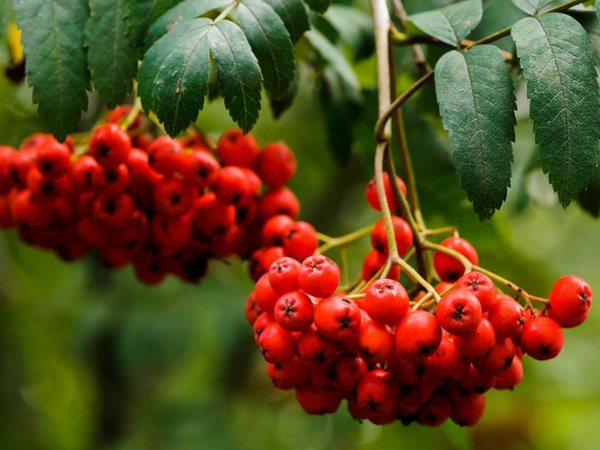

As for the choice of soil, the most common one is suitable for ordinary mountain ash, but on neutral, drainage, the yield will be higher, and on light, sandy, sandy loam - lower, growth is worse. It will not suffer from the close presence of groundwater. Before planting rowan, it is advisable to give the selected place for two years for the cultivation of vegetables and grain crops.
Preparatory work on the site
Preparatory work begins with the arrangement of pits at a distance of 3-6 meters. The depth, width of each - on average 60 × 60 cm (take into account the size of the root system of the seedling). Lay a drainage layer on the bottom (broken brick, large crushed stone, expanded clay will do). Mix fertile soil, peat compost or humus (5 kg), superphosphate (150-200 g), potash fertilizer (100 g) and fill a third of the planting pit with the resulting mixture. Next, half-fill with ordinary soil and water abundantly.
Preparation of rowan seedlings
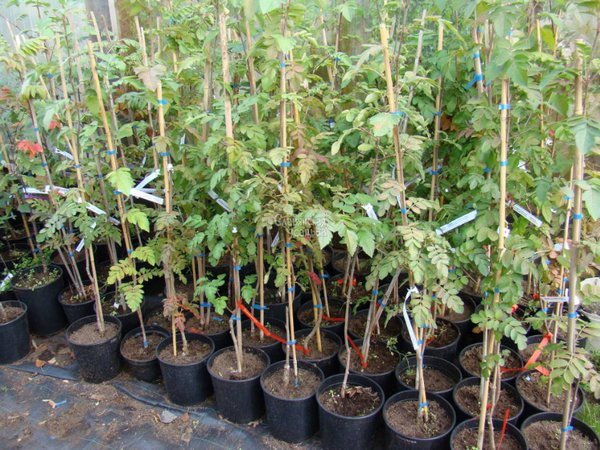

The preparation is very simple. Get rid of sick, bruised, dried roots. The above-ground part of the seedlings also requires the same manipulations. Use a clay root shaker to avoid drying out.
Important! If planting occurs in the spring, then the roots are previously kept in water for two days. And from the seedlings purchased in the autumn, it is necessary to carefully remove the leaves without damaging the buds, in case of too late purchase - dig in the mountain ash for the winter.
The process of planting rowan seedlings
Wait for the water to soak into the soil after watering and make a small indentation in the center of the hole, place the seedling there and spread its root system. Cover the plant with soil so that it is 2-3 cm deeper than it grew in the nursery. Tamp the soil a little and water again abundantly. Mulch the soil with a layer of humus, peat or other organic matter (grass, hay, straw) 5-10 cm thick.
Read also:
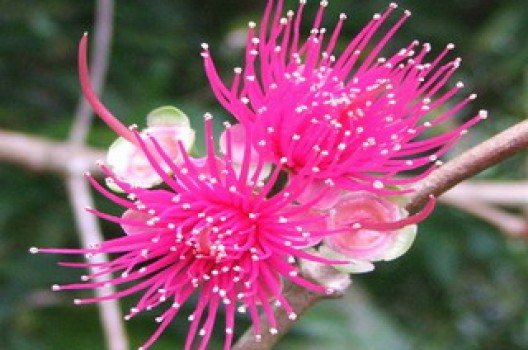

06 Mar 2019
Malay rose apple
Malay apple or Yambose (Syzygium malaccense). The genus Syzygium, the Myrtle family. ...
To read
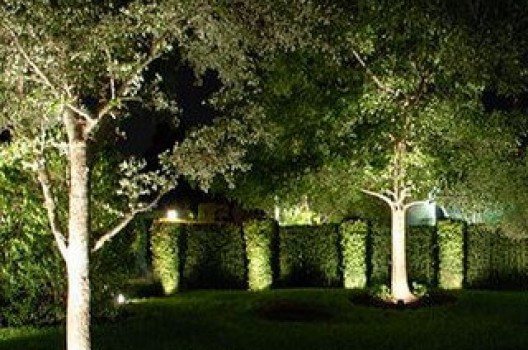

06 Mar 2019
Lighting and lighting trees
Any park area, garden, square or alley needs high-quality ...
To read
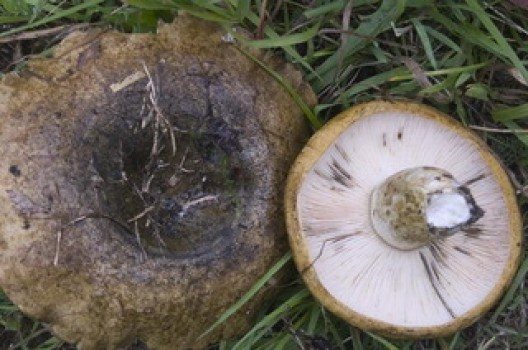

06 Mar 2019
What does a mushroom leaflet look like: photo and description
It so happened among the people that many mushrooms are given "speaking ...
To read
Rowan - main characteristics and popular varieties
Rowan belongs to the genus of deciduous trees or shrubs, characterized by high frost resistance and unpretentiousness to the composition of the soil. Feels good both in forests and in mountainous areas. Its cultivation is widespread throughout Russia, including the Far North. The plant is easy to propagate and, if desired, you can create a whole garden from various varieties of this culture.
For a long time, this tree has been planted near the house, it is believed that it is able to protect against the evil eye of unkind people. Taking advantage of the fact that the shoots are characterized by elasticity and hardness, spindles and staves were previously made from them, and nowadays baskets and some other elements are woven for decorating the interior and garden area. Various products are cut from wood of this species: spoons, dishes.
The fruits of the plant are used much more often than branches, from which jam and jams are made, they are added to desserts. Ripe berries are used in the production of vegetable tissue dye. In addition, they are harvested and dried to create beads and decorative items.
Many gardeners have already identified for themselves the most beloved rowan varieties, which in practice have distinguished themselves by the abundance of the harvest and the taste of the fruits, these are:
- 1. Large scarlet - the most valuable species, the weight of its berries reaches 4–5 grams, in color they resemble cherry fruits. From a mature tree, up to 150 kilograms of a crop can be harvested per season, characterized by juiciness and lack of bitterness. This variety was obtained as a result of hybridization of common mountain ash and several types of pears.
- 2. Pomegranate - characterized by especially large fruits, the size of a cherry. The yield is very high, up to 170 kilograms from a culture over 6 years old. The berries are sweet and sour, there is no bitterness. The variety appeared from crossing rowan with large-fruited hawthorn.
- 3. Titanium - its main quality is increased frost resistance, this variety is planted in regions with severe winters. Titanium was the result of crossing rowan with pear and red-leaved apple. Fruits are small, about 2 grams in weight, the plant is medium-sized with a wide crown shape.
- 4. Rowan beauty - a tree with a pyramidal crown, grows up to 6 meters. The variety originated from crossing rowan with pear. The beauty yield is high, the fruits are up to 2.5 grams of orange-red color. This species is distinguished by an unusual oblong shape of the berries. Their taste is slightly tart, but devoid of bitterness.
Some varieties are planted in the garden area more for the purpose of decorating the site than for harvesting. However, these species also boast excellent fruit taste.
- 1. Kene is a bonsai with graceful leaves and large pearl or white berries. Upon reaching the fruiting age, it becomes, if not the main, then one of the main decorations of the garden - it looks very decorative. Its height does not exceed 2 meters.
- 2. Ruby - a dwarf plant with a spreading crown, grows up to 2.5 meters. The fruits are very tasty, sweet and sour, their weight does not exceed 2 grams. The color of the berries is dark ruby.
A description of the main criteria for each species will help the gardener navigate the variety of varieties of this fruit crop and choose the best option for himself. People often hear the name - chokeberry. It is a misconception that a plant with a similar fruit shape is a species of mountain ash, in fact, it is chokeberry.
Both plant species - chokeberry and mountain ash - belong to the pink family and are related in the botanical hierarchy, however, looking closely at them, you can see that they are completely different. The first is a shrub that grows from a meter to two and a half, its leaves have a completely different structure, different from the leaf plates of the second.
Where to plant rowan on the site.Why is it necessary to plant rowan near a private house
Most owners of private buildings try to plant their favorite shrubs and trees on the site. Is it possible to plant rowan near the house?
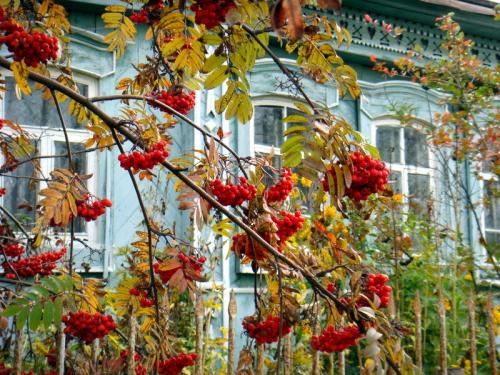

Signs and superstitions
Before planting a plant near a building, it is important to weigh in advance not only the features of its growth, but also take into account folk signs.
It is popularly believed that the mountain ash tree has a mystical power that protects against negative energy and helps mainly women. It is able to protect the female sex from negative influences, gives fertility.
Let's consider a few important signs.
- If a tree grows on a site near the fence by itself, this will indicate the presence of supernatural abilities in one of the residents;
- If you want to reliably protect your home from thieves, fires and ill-wishers, plant three small trees around it;
- If you want to protect your home from visits of evil spirits, you need to plant a tree right next to the window so that the twigs can be attached to the window. They can be fixed with wire or simply hooked onto something. And even if you attach a plucked twig to a door or porch, it will help protect residents from sorrows and diseases;
- If women live in the room, then in order to preserve their youth, it is important to plant a young tree. Also, a tree with red berries is considered a symbol of fertility, therefore it helps women to get pregnant;
- Even one small plant with red berries attracts health. Pick berries and leaves from it, make a decoction and let a sick family member drink it at least 3 times a day.
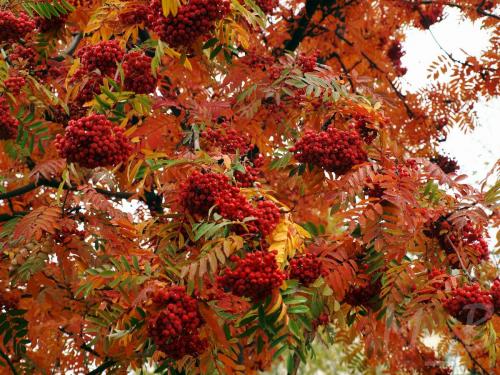

Even if the mountain ash grows not near the building itself, but not far from it, the tree can also be used for good purposes. For example, you can put leaves under the pillow for newlyweds - they will protect young people from the evil eye and envy, and attract love. And if the beads made of berries are worn by the bride at the wedding, it will make her beauty and health protected from evil tongues. Rowan brings love to unmarried girls.
Also, since ancient times, people have laid out rowan branches along the road from the cemetery, returning after the funeral. It was believed that this would help the soul of the deceased to leave the earth faster and bring peace in the other world.
There are many signs. And if you plant a tree in front of the house, it will make you and yours to the maximum protected from all misfortunes. But there are things that are strictly forbidden to do in order not to get the opposite result.
What can not be done with rowan
So, in no case should you just cut off branches or break a tree. It is believed that this can incur serious illness and misfortune. If you need to do this for some good purpose, then at least mentally be sure to ask for forgiveness for the pain caused and explain why you need its branches, leaves or fruits.
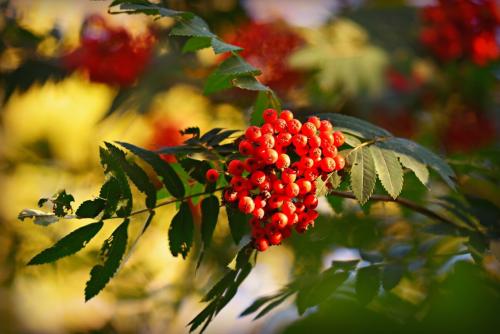

Signs about the weather
The answer to the question of whether it is possible to plant rowan near the house is clear. And if the plant grows near the porch, you can easily predict even the weather from it. More berries indicate a long frosty winter. If they ripen for a long time, the spring will be late and cool. And if the berries fall in large quantities from the branches, without having time to fully ripen, this indicates a summer with rains and a bountiful harvest.
Can you plant rowan near your home? It is even necessary to do this if you believe at least a little in folk omens and want to preserve your health and the health of your loved ones, as well as protect your home from evil spirits and misfortunes. This plant has some advantages, the main thing is to choose the right place to plant a tree in front of the house.
Like and subscribe to the channel so as not to miss new publications.
More information on gardening here.
Care rules - pruning, feeding and pest control
Caring for rowan trees in the garden consists of watering, seasonal pruning, feeding, loosening the trunk circle and treating pests - these are the most basic procedures that are necessary for every plant grown in the garden. The culture does not require any additional care or attention from the owner.
Trimming and fertilizing the soil should be carried out in the spring as soon as possible, because the mountain ash wakes up early after the winter period and resumes its development.
The principles of pruning depend on the age of the plant: in young trees, long thin shoots are shortened to the outer bud, damaged fragments are cut off. The crowns of abundantly fruiting mountain ash are thinned out so that the sun's rays can freely illuminate and warm all parts of the tree, including the main trunk. For this, all shoots growing inside the crown, or crossing each other, are removed or shortened to the outer bud. Branches are also cut off, the growth of which is directed towards the ground.
For mature trees, whose growth is significantly weakened, rejuvenating pruning is performed. To stimulate the growth of young shoots, all poorly fruiting branches over 4–5 years old are carefully cut.
Of course, it is necessary to cut off the diseased and frozen parts of the plant during the winter. Infected leaves and shoots should be burned immediately to prevent the spread of the disease in the garden. Places of cuts must be lubricated with garden varnish or oil paint based on drying oil - this will help the mountain ash to recover faster from the damage it has received and protect it from infections.
After the tree reaches 3 years of age, you can start feeding it with mineral fertilizers. This is done three times a year: before the spring bloom, in the summer and after the berry harvest. The selected funds are shallowly embedded in the soil when loosening, then the mountain ash is watered abundantly.
So, in the first half of April, it will be useful to add 20 grams of nitrogen, 25 grams of phosphorus and 15 grams of potash fertilizers per square meter to the soil. To do this, you can use agents such as superphosphate, urea, potassium salt, or other drugs that a particular gardener prefers. In July, the dosage of each mineral is reduced to 10 grams, and in the fall, only phosphorus and potassium are introduced - 10 grams each. Nitrogen during this period will be inappropriate and may even be harmful, as it activates the growth of the green part of the plant, which is unacceptable before frost.
Rowan positions itself as a culture that is quite resistant to diseases and pests, but in some years it can be attacked by sawflies, caterpillars, ticks, ants or mountain ash moth. When signs of a disease appear, regardless of the season and the presence of flowers on the branches, it is recommended to immediately cut off all damaged fragments and burn them. The tree itself should be sprayed with a solution of nicotine sulfate and ordinary laundry soap.
Red mountain ash - medicinal properties and contraindications
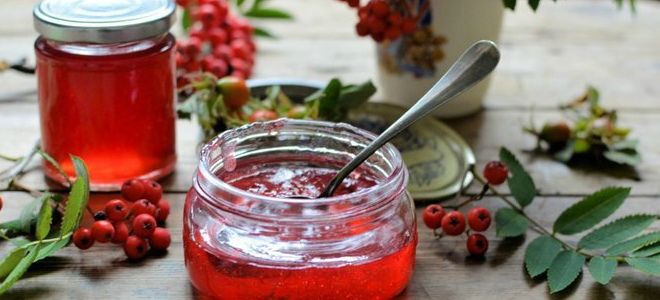

What is a red mountain ash, useful properties and contraindications for many years have been well studied by domestic doctors and biologists. Now parasorbic and sorbic acids have attracted special attention of scientists, it turned out that they also block the growth of microorganisms, fungi and mold, which gives impetus to new developments. Healers knew this feature many years ago, advising women to take infusions and berries for fungal ailments and thrush.
But pregnant women cannot use such a medicine, since the fruits of mountain ash increase blood clotting and can provoke a miscarriage or childbirth, and later cause an allergy in the baby. The exception is in small doses, with severe early toxicosis, but only after consultation with the doctor. Children can be given berries from 3 years old, several pieces or 1 teaspoon of jam, increasing the amount to 1.5 tbsp. spoons by 10 years.
The considerable health benefits of red rowan are due to its valuable composition:
- cellulose;
- amino acids;
- vegetable proteins;
- phospholipids;
- flavonoids;
- terpenoids;
- anthocyanins;
- organic acids;
- fructose, glucose, sorbitol, pectins;
- glycosides;
- carotenoids;
- essential oils;
- minerals, vitamins.
Red mountain ash - medicinal properties
Today, it is widely known why red rowan is useful, in this list there are anti-inflammatory, hemostatic, astringent, diuretic properties. Berries lower blood pressure, increase blood clotting, for which they are especially valued in the treatment of hypertension, heart and vascular diseases. And rowan phytoncides destroy Staphylococcus aureus, Salmonella, mold.
What else is red mountain ash valuable - useful properties:
- fights intestinal infections;
- raises immunity after illness;
- improves metabolism;
- lowers cholesterol levels;
- relieves flatulence, removes toxins.
The fruits of this tree help in the treatment of:
- rheumatism;
- tuberculosis;
- anemia;
- whooping cough;
- edema;
- gastritis.
Red rowan - contraindications
But we must not forget that if red rowan is chosen for treatment, the health benefits and harms can be balanced if it is used incorrectly. Among the contraindications are individual intolerance, allergy to berries or components of deciduous broths. Therefore, it is important to check in advance if there is any incompatibility, so as not to provoke side effects.
Healing products from berries and leaves, which are rich in red rowan, are contraindicated in:
- gastritis with high acidity;
- urolithiasis in the acute stage;
- hypotension;
- a stomach or duodenal ulcer;
- recent heart attacks or strokes;
- ischemic heart disease;
- heart failure.
Honor and respect
In Ancient Russia, a mountain ash necessarily grew in every garden - as a symbol of happiness and peace in the family. One of the Christian holidays is dedicated to this culture - the day of Peter and Pavel Ryabinnikov. Many agricultural signs have long been associated with mountain ash: it blooms - it's time to sow flax, it blooms well - to a rich harvest of flax, blooms late - by the long autumn ... Mountain ash has always been in high esteem. Its branches were used to decorate the dwelling, powder from dried fruits was added to flour. Boiled in honey, pickled or sun-dried berries were served among other dishes. - I think you will be surprised to learn that mountain ash is a relative of the rose, they belong to the same family of Rosaceae, -
He speaks
Junior Researcher of the Department of Berry Crops, RUE "Institute of Fruit Growing" Lyudmila Murashkevich
. —
The first to look at the common mountain ash was Ivan Vladimirovich Michurin. By crossing it with various plants, he developed new varieties. "Burka" - a hybrid with Alpine mountain ash, "pomegranate" - with blood-red hawthorn, "liqueur" - with chokeberry. Later, breeders experimented with loquat, apple and even pear. So, the varieties "scarlet large" and "beauty" were obtained from crossing the Moravian mountain ash and a mixture of pear pollen. In the world flora, there are about 90 species of mountain ash, but only 14 species have been introduced into the culture. And the most widespread is the mountain ash. Also cultivated are such sweet-fruited forms of mountain ash, such as Moravian, sweet-fruited, nevezhinsky, large-fruited, or homemade.
Selection
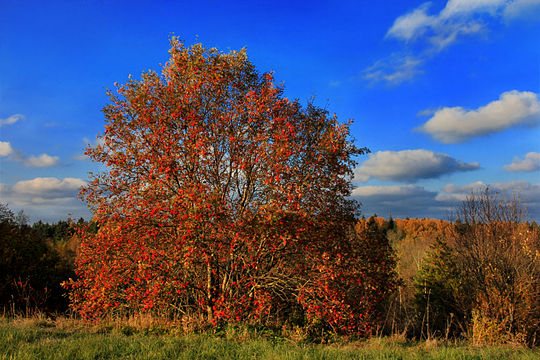

Rowan in autumn
The mountain ash has a bitter taste, which reduces their nutritional value. Only in the 19th century were mutant forms with fruits devoid of bitterness isolated. The 'Edulis' cultivar was originally found in 1810 in the Altwater mountains near Spornhau. Later in 1899, another form with non-bitter fruits was discovered, called 'Beissneri'.
Over a two-hundred-year history, many seed offspring of these rowan trees have been obtained, united in the Moravian cultivar group. The selection among the seedlings was aimed at increasing the mass of fruits. The most large-fruited and productive forms were fixed by means of vegetative reproduction. Reproduction of two forms - 'Rossica' and 'Rossica Major' - was started by the German company of Shpet in 1898 and 1903. They had fruits about one and a half times larger than those of the original forms of the Moravian mountain ash.Later, other large-fruited varieties of the Moravian cultivar group were obtained in Germany at the Institute for Breeding Fruit Crops Dresden-Pilnitz and at the Fruit and Berry Institute in Drazdiany in the Czech Republic [6].
In Russia, non-bitter forms of common mountain ash were found in the village of Nevezhino, Nebylovsky district, Vladimir region [7], from where they spread widely in the center of Russia. By means of folk selection, a number of varieties were selected subsequently registered under the names ‘Kubovaya’, ‘Yellow’, ‘Red’. The variety of forms is due to both seed reproduction and the selection of kidney mutations. Several promising varieties of the Nevezhinsky variety group were registered by the Soviet pomologist E.M. Petrov. Later, he continued breeding work with mountain ash and received a number of hybrids from crossing the Moravian and Nevezhinsky mountain ash with each other and Michurin varieties.
The Russian breeder I. V. Michurin played an extremely important role in improving the range of mountain ash. As the main object of his work, he used the common bitter mountain ash, which he crossed with chokeberry, rowan glovina, apple, pear, hawthorn and medlar.
In the future, work on the selection of mountain ash continued in the city of Michurinsk in VNIIG and SPR. There were created varieties ‘Businka’, ‘Vefed’, ‘Daughter of Kubovoy’, ‘Sorbinka’, which are the result of crossing the Nevezhin and Moravian mountain ash.
The selection work with mountain ash was also carried out in VIR and other Russian institutions [6].
Where does red rowan grow?
The Latin specific epithet of common mountain ash - aucuparia comes from lat. avis - bird and capere - to attract, to catch.
This is due to the fact that rowan fruits are attractive to birds and were used as bait for catching them.
Rowan is a plant that is widespread almost all over the world. It is known in European countries, popular in Western Asia, in the Caucasus.
Reaching the Far North, in the mountains it rises to the very border of vegetation, and there, it already takes the form of a bush.
In other words, where the mountain ash grows, a temperate climate prevails.
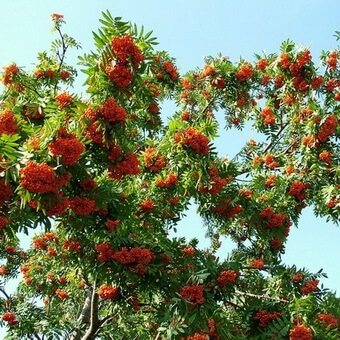

In Russia, red rowan is common in the forest and forest-steppe zone of the European part, in the North Caucasus, in the Urals. Grows in separate specimens, without forming continuous thickets, in the undergrowth or the second tier of coniferous, mixed, occasionally deciduous forests, in forest glades and forest edges, between shrubs.
Russian gardeners consider mountain ash to be one of the most unpretentious crops, and this is true. It can grow in any soil, including infertile and acidic ones. However, the quality of the soil directly affects the fruiting of this plant.
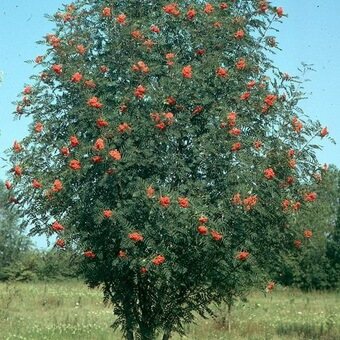

The common mountain ash tree can grow equally well both in the sun and in partial shade, but in the second case, the gardener gets an elongated slender tree trying to reach the sunlight. In well-lit areas, the common mountain ash gives an excellent harvest.
The advantage of this plant is its friendliness with any other crops growing nearby on the site.
The following is a botanical description of the common mountain ash and recommendations for tree care.
Fruit use
Rowan has always been valued by folk healers as the main healing plant. The Russian people have always revered this plant. In Russia, it was customary to carry a sick person under a mountain ash so that her spirit took away the disease. Previously, a bitter jam was made from the fruit to calm the nervous system. The bark of the tree was used to heal the liver.
Our ancestors fermented ripe berries, covered them with sugar, poured honey, dried them. Berries that were already caught by the frost were especially appreciated. A special paste was made from them, rubbing with powdered sugar. From stones in the kidneys and gall bladder, they cooked a special porridge made of mountain ash berries.
Rowan fruits are a multivitamin remedy, there are many vitamin charges in it. It is an excellent astringent, laxative, diuretic, choleretic, hemostatic and estrogenic drug.Rowanberry extract is a part of many pharmacy multivitamins, drugs to increase immunity, lower cholesterol and blood pressure.
Rowan description
Rowan is a genus of low woody plants of the tribe Apple of the Pink family. The buds of the culture are felt-fluffy. The leaves are large, with 11–23 oblong leaflets. Numerous white flowers are collected in dense inflorescences that form at the ends of the branches. The flowers have a strong specific aroma.
Rowan fruits are spherical bright red juicy apples with small seeds, rounded at the edges. Berries contain approximately 8% sugars, organic acids, vitamins C and P, glycosides and carotene.
Currently, there are more than 100 species of mountain ash, one third of which grows in Russia. The culture is widespread in Europe, Asia and North America.
The tree has high frost resistance, unpretentious soil. It grows calmly in areas with a close location of groundwater.
Rowan ordinary belongs to the number of low-value fruit crops due to its prevalence and low quality of berries. As a rule, it is used as an ornamental tree, fruits are used for food, and wood is used for joinery.
Reproduction of the plant occurs with a vegetative and generative method. As a rule, the species mountain ash is grown from seeds. Sowing of seeds takes place in the fall.
Types and varieties
On the basis of common mountain ash, many varieties have been bred. In total, there are more than 100 of them. They differ from each other:
- height;
- trunk thickness;
- the length of the shoots;
- color and taste of berries.
The most popular and disease and frost resistant varieties that can be grown in your garden are presented in the table:
| Name | Characteristic | Photo |
| Bead | A short tree with ruby-red berries that taste like cranberries, bears fruit in the 4th - 5th year after planting | |
| Scarlet Large | A fast-growing variety with large bright red fruits weighing up to 4 g. Berries are tart, but not bitter | |
| Titanium | Medium-sized tree, dark red fruits with a bluish bloom. Bears fruit every year |
|
| Dessert | A low-growing tree that bears fruit in a year. Requires fertilization. Berries are dark, tart, juicy | |
| Michurinskaya | A valuable variety with large berries with a sweet and sour taste, it is a medium-sized tree | |
| Liqueur | Reminiscent of chokeberry, both in taste and in appearance, with a sweet, slightly astringent taste. Suitable for winemaking |
Along with the usual red varieties and chokeberry, yellow and white rowan clusters can often be seen in the gardens. So, for example, the variety Yellow is a high-yielding one. The branches of this mountain ash, weighed down with fruits, literally bent to the ground. The berries are juicy, suitable for making jams and pies.
Mountain ash of the Solnechnaya variety is not so fruitful, but its berries are tasty, without bitterness. She was bred by spontaneous hybridization of Nevezhinskaya Kubova, therefore she is sometimes called the Daughter of Kubova.
Kene and White Swan varieties are considered separately.
They are unfit for human consumption and are grown as ornamental plants.
Garden species of mountain ash are not only trees and shrubs with high-vitamin fruits. Among other plants, they create beautiful and bright colors.
Taxonomy
Many previously described types of mountain ash were later combined with the species Sorbus aucuparia
, and their names have become synonymous with the species:
Synonyms
- Sorbus altaica Koehne
- Sorbus amurensis Koehne - Amur mountain ash
- Sorbus anadyrensis Kom.
- Sorbus aucuparia var. typica C.K. Schneid.
- Sorbus boissieri C.K. Schneid.
- Sorbus boissieri var. adsharica Sosn.
- Sorbus camschatcensis Kom.
- Sorbus glabrata (Wimm. & Grab.) Hedl.
- Sorbus kamtschatcensis Kom.
- Sorbus pohuashanensis (Hance) Hedl. - Rowan pohuashanskaya
- Sorbus pohuashanensis var. amurensis (Koehne) Y.L. Chhou & S.L. Tung
- Sorbus polaris Koehne
other synonyms:
- Aucuparia sylvestris Medik.
- Mespilus aucuparia (L.) Scop.
- Pyrenia aucuparia (L.) Clairv.
- Pyrus aucuparia (L.) Gaertn.
- Pyrus aucuparia var. typica (C.K. Schneid.) Asch. & Graebn.
- Pyrus rossica A.D.Danilov
Infravids
Other species began to be considered as subspecies or forms of common mountain ash: There are several subspecies and forms:
- Sorbus aucuparia subsp. maderensis (Lowe) McAll.
- Sorbus aucuparia subsp. pohuashanensis (Hance) McAll.
- Sorbus aucuparia subsp. praemorsa (Guss.) Nyman
- Sorbus aucuparia subsp.sibirica (Hedl.) Krylov [syn. Sorbus sibirica Hedl. - Siberian mountain ash]
- Sorbus aucuparia f. xanthocarpa (Hartwig & Rümpler) Rehder
The status of some varieties remains uncertain:
- Sorbus aucuparia var. fastigiata (Loudon) Hartwig & Rümpler
- Sorbus aucuparia var. xanthocarpa hort. ex Hartwig & Rümpler
The benefits of the fruits of ordinary mountain ash
The main application of the common mountain ash is food, melliferous, medical, decorative and phytomeliorative.
Fruits contain sugar (up to 5%), malic, citric, tartaric and succinic acids (2.5%), tanning (0.5%) and pectin (0.5%) substances, sorbitol and sorbose, amino acids, essential oils, salts of potassium, calcium, magnesium, sodium, as well as carotenoids (up to 20 mg%), ascorbic acid (up to 200 mg%), flavonoids, triterpene compounds, bitter substances, sorbic acid. Due to the benefits of the fruits of the common mountain ash, they are used in medicine as a multivitamin and carotene-containing raw material.
Rowan fruit is used as a medicinal raw material, which is harvested mature in August - October before frost, dried in dryers at 60 ... 80 ° C or in well-ventilated rooms, spreading in a thin layer on cloth or paper.
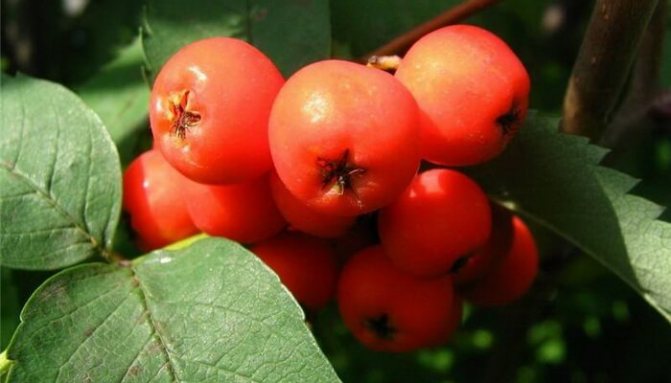

Because of the bitterness in fresh form, fruits are practically not eaten, more often after frost, when they lose their bitterness. They are mainly used for processing. They are excellent raw materials for the alcoholic beverage and confectionery industries, the production of soft drinks. When canning, they are used to prepare jelly, sweets such as "mountain ash in sugar", jam, marmalade, jam, marshmallow. The fruits are dried and made into "fruit powders" and flour.
To remove the bitterness from the fruits of mountain ash, they are poured with boiling water and brought to a boil over high heat, but not boiled. The hot water is immediately drained, the fruits are poured with cold water and the water is changed several times within 5-6 hours. After that, they are covered with sugar (1: 1) for 3-4 hours, then boiled in several steps, like any 5-minute jam. Then the fruits become transparent, and the skin is soft, and there is no better seasoning for meat or fish!
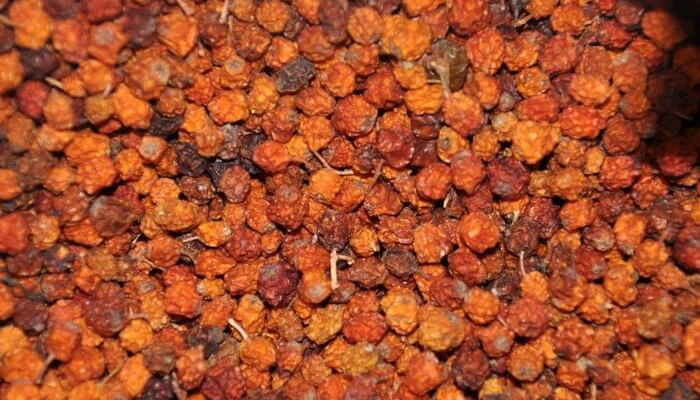

Rowan is a medium-productive spring honey plant that gives bees nectar and pollen; nectar productivity - up to 30 ... 40 kg per hectare of plantations. Rowan honey is reddish and coarse-grained, with a strong aroma. Rowan fruits are rich in vitamin C (up to 160 mg%) and carotene (up to 56 mg%).
Rowan is appreciated not only for its useful fruits, but also for its decorative qualities. It is used in ornamental gardening, gardening of plots and decoration of adjoining territories. This tree retains its attractiveness throughout the year. It looks very beautiful in winter, as well as during flowering. It is impossible to look away from the autumn leaves of mountain ash - variegated, bright colors envelop the entire plant.
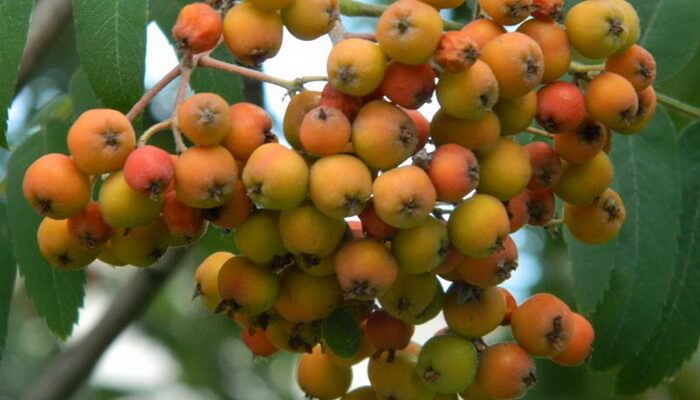

It has many garden forms, including weeping, narrow-pyramidal, yellow-fruited, with pinnate-lobed leaves, etc. It has fractional-porous reddish wood, from which turning products, decorations, and furniture are made. Mountain ash bark can be used as a raw material for tanning.
Wild birds feed on the fruits of mountain ash, which often saves them from hunger in winter. Ripe fruits are also used as feed for poultry and livestock.
Rowan: growth, development, reproduction and use
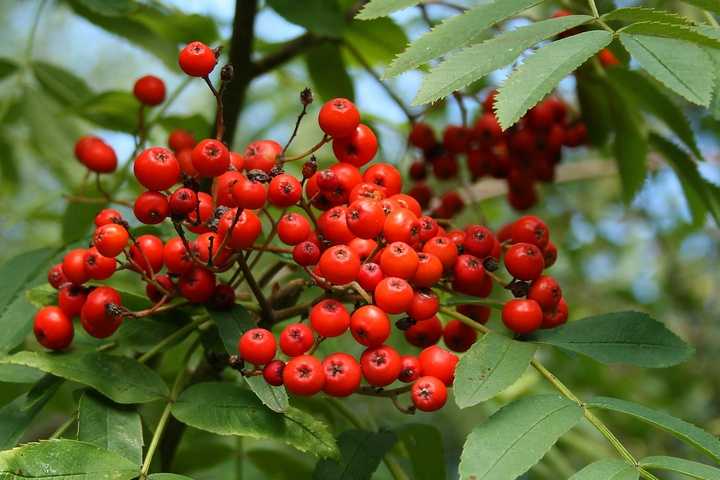

Rowan when germinating, it brings the cotyledons to the surface. They live in most species from 50 to 80 days. Life expectancy is higher at high air humidity. Rowan starts growing earlier than apple and pear, but blooms a week later. By the time of flowering, the shoots reach almost full size and soon after flowering they finish growing, which determines the high frost resistance of mountain ash. In the first year of life, seedlings develop slowly, and from the second or third year, intensive growth of shoots begins. Young trees often have pyramidal crowns that change with age under the influence of the severity of fruits, foliage, as well as the mutual shading of the branches into rounded ones.
Most mountain ash is dominated by apical growth. The apical buds give rise to powerful shoots (up to 100-120 cm long), while the lower ones remain dormant, which determines the tiered crown. When forming the crown, the shoots must be shortened. Simple vegetative buds give rise to growth shoots. Inflorescences are formed from generative buds that form on fruiting twigs-ringlets (branches 1-3, sometimes up to 5 cm long with ring-shaped traces of fallen petioles) and on spears (branches up to 15 cm long with a generative bud at the top). Common mountain ash ringlets live five to seven years, in domestic ones - longer than in all other species (12-16 years).
In the spring, a short shoot with three to four leaves and then an inflorescence develops from a generative mixed bud. The flowers are bisexual with a strong odor. First, the pistil ripens, and then the anthers, which is important for cross-pollination. Rowan blooms up to twelve days. Rowan is partially self-fertile, and all varieties of Nevezhinsky and Michurinsky mountain ash are self-sterile, but pollinate each other well.
Most mountain ash species are characterized by a horizontally spreading type of root system - surface anchor or surface comb. In annual seedlings, taproots and short lateral roots are formed. The depth of their occurrence is from 5 to 30 cm. The lateral roots, branching out, form many small (fibrous) roots. The diameter of the root system of young trees is twice the diameter of the crown. In adult plants, the roots spread to the side by five to six meters, the diameter of the root system is 1.3 times greater than the diameter of the crown. The bulk of the overgrowing fibrous roots is located at a depth of 40 cm. The peculiarity of the occurrence of roots in rowan must be taken into account when cultivating the soil. Almost all types of mountain ash form abundant root growth. Increased overgrowth formation causes root damage during soil cultivation. The lifespan of the common mountain ash is about 60 years, but specimens are known exceeding 200 years in age. The growing season lasts 182-189 days.
Rowan trees are a winter-hardy tree species. Even in especially harsh winters, when the temperature drops to minus 45 ° C, the mountain ash and non-vezhin varieties are not damaged. Mountain ash Moravian and Bereka endure frosts of thirty degrees. The least winter-hardy species is the domestic mountain ash. Vegetation begins at relatively low temperatures, earlier than most fruit plants, but flowering takes place when the average daily temperature reaches + 15-16 ° C. The leaves of the common mountain ash fall off two weeks earlier than that of the apple tree, so by winter it has fully matured wood and buds, which determines its high winter hardiness. The roots of the trees are also highly frost-resistant.
Rowan grows best and bears fruit in well-lit, moderately humid places. Under the canopy of the forest, her productivity and life expectancy are reduced. Aria and home are the most demanding of light. The best soils for mountain ash are chernozems and dark gray forest loamy soils. Groundwater in areas where mountain ash is planted should lie no closer than one and a half meters from the soil level. And at the same time, young nevezhinsky mountain ash without watering in dry years can die, and adults can drastically reduce the yield. Rowan needs moisture in the spring, during the period of active growth of shoots, as well as during the period of fruit growth and laying of branch buds for the next year's harvest. Seedlings are very demanding on water supply. Reproduction, cultivation and care:
Rowan trees reproduce by seeds, and garden sweet-fruited varieties mainly by vegetative means (budding, grafting, root suckers or layering). The seed breeding method of mountain ash is widespread. To obtain seedlings, seed stratification is required (from 3 to 6 months).If the seeds were formed in a wet and cool summer, their period of stratification is short, and after a dry summer, it is long. To obtain healthy seeds, the fruits are crushed and washed immediately. Wet they are mixed with peat in a ratio of 1: 3 and placed in a box. During stratification, peat is constantly moistened, making sure that it does not become strongly compacted. Stratification is carried out in a basement at a temperature of 1 ° C. As soon as five percent of the seeds hatch, the box is placed in a glacier or under the snow, covered with a thick metal mesh from mice. A layer of snow 50-60 cm thick and a layer of sawdust (up to 15 cm) are poured on top.
In spring, rowan seeds are sown on ridges prepared in the fall. The soil on the ridges should be light and abundantly fertilized with humus, phosphorus and potassium fertilizers (100 and 50 g per 1 sq. M, respectively). Seeds are sown in grooves prepared 25 cm apart from one another to a depth of 2-3 cm (3-5 g of seeds are sown per 1 m of groove length). From above, the grooves are covered with humus earth. This prevents the formation of a crust, the seeds do not dry out and sprout together. After germination, the seedlings are thinned out, leaving a distance of at least 8 cm between them, otherwise they will stretch out and fall. You can sow rowan seeds without stratification in late August or early September using the same technology. With later sowing, the seeds can give mass shoots not in the first, but in the second spring, since they do not have time to undergo stratification.
Seedling care consists in weeding, loosening row spacings, feeding with nitrogen fertilizers. The first feeding is carried out when three to five true leaves appear with a solution of urea or ammonium nitrate (at a concentration of 0.1-0.2 percent), and after 25-30 days - the second, higher concentration. With good care, by the fall of the first year of life, the seedlings have a well-developed root system and a stem with a thickness of at least 7-8 mm at the root collar. The easiest way is to propagate rowan by growth. Two-, three-year-old shoots with good care are ready for planting in a permanent place. The annual is first planted in the beds for growing. The quality of the planting material is significantly improved if the shoots are separated from the roots of the mother plant and transferred to their own roots. To do this, in early spring, at a distance of 20-25 cm from the growth with a sharp shovel, cut the root coming from the mother plant, and leave the stem in place. In two years, it forms its own root system and can be transplanted to a permanent place.
To obtain cuttings, one- or two-year-old shoots are usually used. The soil around the mother rowan is abundantly fertilized with humus, dug to a shallow depth, choosing weeds. Grooves with a depth of 8-10 cm are made from the trunk, shoots are laid in them, strengthening it with wire or wooden hooks. For better rooting, you can use a thin wire to slightly pull the patch of leaves where it enters the groove, and cut the bark from below. The top of the shoots is tied to a vertical peg, the groove is covered with loose earth and watered abundantly. Watering is carried out regularly during the summer. At the same time, the layering is fed with a urea solution (at a concentration of 0.2-0.3 percent). After a year, and if the roots are weak, then after two years, in early spring, the cuttings are cut from the mother plant and left in place until autumn for better rooting. In the fall, it is planted in a permanent place.
For layering, you can also use the lower branches of the crown, but they take root worse than the shoots. Cuttings are also poorly rooted, so mountain ash is not propagated by cuttings. For reproduction of valuable forms of mountain ash, grafting (budding) is used. As a stock, take rowan seedlings, the bark of which is elastic, it separates well during budding, providing a high survival rate of the eyes. For nevezhinsky mountain ash dwarf stock is black chokeberry. These varieties grow on it less intensively than on the mountain ash. In the third year after planting, the trees begin to bear fruit.Irga as a stock is less suitable due to the abundance of root growth. Rowan is circled in the first half of August (earlier than the apple tree). The technology is the same as that of fruit breeds.
Growing rowan seedlings has its own differences. First of all, in the spring of the year following budding, the stock is cut into a thorn 15-18 cm high, on which all the buds are removed. A shoot growing from a grafted kidney is tied to it. One-year-old scion grows, as a rule, above a meter. In the second spring after budding, a crown is formed. To do this, remove the upper part of the one-year-old with contiguous buds, since shoots grow from them, at an acute angle to the trunk. If the tree is not intended to be grown in alleys, it is formed short. The best type of crown for mountain ash is a sparse-tiered crown, in which no more than three branches are laid in the first tier. Considering that mountain ash starts growing early, it is better to plant it in the fall. To obtain good yields, the soil for planting them is prepared as for other fruit species, organic, phosphorus and potash fertilizers are applied for plowing. The feeding area for nevezhinsky mountain ash is 6x4, 6x3 m. Pits are dug 80 wide, 50-60 cm deep. Two buckets of humus, 250 g of superphosphate and 100 g of potassium salt are brought to the bottom. All this is covered with a fertile layer of soil and trees are planted.
The cultivated plants are planted so that the root collar is four to five centimeters above the soil level (when the soil subsides in the pit, it will be at the same level with it). Plants from cuttings or root suckers are planted in the soil four to five centimeters deeper than they grew in the school or near the mother plant. Planting is abundantly and regularly watered. After the first watering, the planting lanka is mulched with humus, chopped straw. When planting for the winter, after watering, the plants are hilled (to a height of 25-30 cm) to prevent the roots from freezing. In the fall, while the plants are weak, their trunks should be whitened to protect them from sunburn in the spring. Planting care includes weeding, shallow loosening, an annual increase in the area of the fertilized near-trunk circle by 0.3-0.4 m (in diameter). When mountain ash enters fruiting, continuous tillage is carried out (in the entire width of the row spacing), fertilizers in this case are also applied over the entire area. Organic and mineral fertilizers are applied every three to four years.
Pruning during planting is reduced to shortening (by a third of the length) of all branches, removing the competitor of the continuation shoot (the continuation shoot is left 20-25 cm above the side branches). During the fruiting period, diseased and damaged branches are cut out, the crown is thinned out, every four to five years, rejuvenating pruning of the ringlet is done, and the main branches are shortened.
For old trees that stopped growing, began to lose branches, reduced yields, apply a stronger rejuvenating pruning: shorten the main branches by a third of their length, the extension of the axis of the main branches is the shoots that have grown from dormant buds, called "tops". At the same time, organic and complete mineral fertilizers are applied to the entire feeding area. Pest and disease control:
Rowan is affected by rowan and rose aphids, hawthorn, ringed and unpaired silkworms, rowan leafworm, sawflies. Control measures are usual with the help of insecticides. In addition, specific pests are found on mountain ash. This is, first of all, a mountain ash moth or a duck, damaging apple trees, a small butterfly with a wingspan of 11-12 mm, its front wings are grayish-brown with a silvery white stripe along the rear edge, interrupted by a dark spot in the middle. The hind wings are lighter in color, with fringes. There are light hairs on the head. The fruits are damaged by caterpillars that penetrate from the calyx of the flower. Therefore, such fruits are difficult to distinguish from intact ones until the caterpillars emerge from them, leaving behind round holes.After leaving the fruit, the caterpillars pupate in the surface layers of the soil under the crown of the mountain ash or in the cracks in the bark on the trunks and branches. Pupae overwinter in the ground under fallen leaves. Butterflies fly out of them in the spring. Their mass years occurs at an average daily temperature of 10 ° C, and after seven to eight days the laying of eggs begins and sometimes continues until August. The female lays from 30 to 90, and sometimes 200 eggs. After 12-13, in hot weather - after 8-10 days, caterpillars hatch from the eggs, penetrating into the flesh of the fruit. They live in fruits from 25 to 40 days. The mountain ash moth gives one generation per year.
In pest control, agrotechnical, chemical and biological control measures are used. Agrotechnical measures include collecting and composting fallen leaves in the fall, shallow late autumn digging of tree trunks, collecting volunteers, since pupae sometimes hibernate in fallen rowan fruits. Chemical protection is used in the years of mass reproduction of moths. In late July - early August, trees are sprayed with any of the available insecticides. The timing and number of treatments depends on the number of pests. It is advisable to spray after flowering and again after 10-12 days. From biological control measures, infection of the caterpillars of the mountain ash moth with polyhedrosis and granulosis viruses is effective. The caterpillars that go into the soil for cocooning are eaten by predatory ground beetles.
Diseases most of all affect mountain ash in humid, rainy years. Many species are harmed by brown leaf spot. The first signs of it appear already in late May - early June. Sometimes spotting appears on the shoots in the form of slightly depressed dark brown spots with a pink rim. The disease causes premature leaf fall, a decrease in yield growth and a deterioration in the quality of fruits. To combat brown spot, spraying with a 1% solution of Bordeaux liquid or other fungicides is carried out at least three times per season.
Usage: The inhabitants of the northern regions use the berries for food fresh, dried, soaked or pickled. Jam, jam and jelly, marshmallow and marmalade, compote, kvass and vinegar are prepared from mountain ash. Rowan fruit jam is prepared after they are fully ripe, often the bitterness from the fruit leaves after frost. The fruits are cleaned of stalks, washed, blanched for 4-5 minutes at a temperature of 95-100 ° C, then poured with sugar syrup. For 1 kg of berries, take 1.5 kg of sugar, add 3 glasses of water and heat until the sugar is completely dissolved. The berries are soaked in the syrup for 6-8 hours. The cooking process is intermittent: after boiling, the container is removed from the heat, cooled, the foam is removed from the jam, again heated to a boil and cooled, and this is repeated four to five times. Chilled jam is poured into a colander, separating the berries from the syrup. The berries are placed in jars, and the syrup is boiled and the fruits laid in jars are poured hot.
To prepare the compote, the fruits are poured with boiling water, insisted for an hour, the water is changed and once again the fruits are allowed to stand in water for about an hour to remove the astringency. Then the water is drained, the fruits are placed in jars, slightly compacted by shaking, poured with boiling syrup and sterilized for 15 minutes in a water bath at a temperature of 90 ° C. To prepare a syrup for 1 liter of water, add 1.5 kg of sugar. Vegetables and fruits, layered with rowan leaves, are stored in cellars for much longer.
Copies and originals
Mountain ash is propagated by seeds and vegetatively - by grafting, root suckers, green cuttings, layering. The easiest way is by seeds. But at the same time, seedlings do not always fully convey maternal qualities. The grafted tree begins to bear fruit in the 3-5th year, and when multiplied by layering and root shoots - in the 5th-7th.
All varietal mountain ash is self-fertile. Therefore, in order to obtain good yields, it is necessary to have at least two different varieties on the site. You can graft them on the same tree. Or plant a wild game from the forest.
Two or more varieties blooming at the same time will provide high-quality pollination and fruit setting.
For every taste
In Europe, mountain ash is considered mainly an ornamental plant. More than a dozen varieties with multi-colored fruits have been bred: from white and yellow to orange and bright red with a great variety of shades. There are also shrub forms.
| Kene. | Pomegranate. | Joseph Rock. |
Joseph Rock is one of the most beautiful yellow-fruited rowan varieties. Kashmir mountain ash has white, like glowing fruits, and Arnold's rowan “kirsten pin” is pink. The berries are also painted in a deep pink color, and the Chinese mountain ash has the Hupegen “pink pagoda”. Raspberry-red fruits in English, squat, Tien Shan, Finnish and Japanese mountain ash. Light red - in Kamchatka. Orange-red in Elderberry, Common, Thuringian and Broad-leaved, orange in Aria. And in a two-color mountain ash, fruits can be cream, orange and red at the same time. Yellowish-brown, blue when ripe berries in the European mountain ash glogovina, or medicinal banks. She also has the largest fruits - up to 12 mm in diameter!
Sweet and sour, without bitterness, elderberry berries ripen in September. It is very convenient to collect them: the bush does not grow higher than 2.5 m. The plant is winter-hardy, drought-resistant, light-loving. In terms of its healing qualities, it is not inferior to ordinary mountain ash.
Rowan Kale is originally from China, but has already acclimatized in our latitudes. These low (up to 3 m) trees are similar to the common mountain ash, but they bloom later - in mid-June. And white, large (up to 8 mm in diameter), sour, without bitterness, fruits ripen in September.


Rowan pruning
Prune the crop in the spring before the buds awaken. Remove all dried, diseased and growing shoots inside the crown and those that extend at right angles. Thinning is necessary for those branches that bear fruit on last year's stems.
The main purpose of pruning is to improve the uniformity of crown illumination, thereby increasing yields. When forming skeletal branches, try to make them come out at a right or obtuse angle.
With a weak growth, it is necessary to carry out anti-aging pruning. It is performed on a 2-3 year old culture, as a result of which the growth of new shoots is activated on it.
Name
Latin specific epithet aucuparia
comes from lat. avis - bird and capere - to attract, to catch. This is due to the fact that the fruits are attractive to birds and were used as bait for catching them [2].
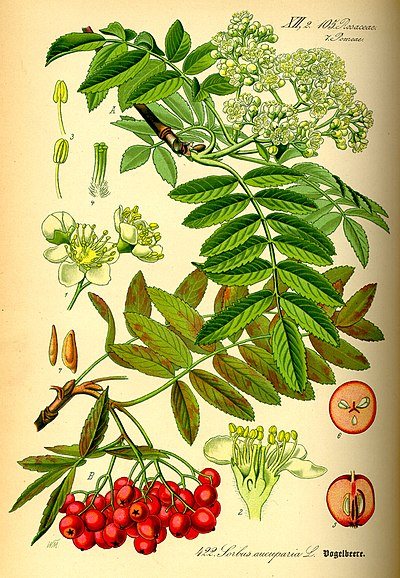

Botanical illustration from the book by O. V. Tome Flora von Deutschland, Österreich und der Schweiz
, 1885.
The benefits and harms of mountain ash
Rowan fruits have many beneficial properties. Red rowan berries contain a lot of ascorbic acid, even more than citrus fruits. It also contains:
- vitamins K and E;
- a nicotinic acid;
- rutin;
- riboflavin;
- provitamin, A;
- glycosides;
- pectins;
- bitterness;
- tannins;
- essential oil, etc.
Thanks to such a rich chemical composition, the following beneficial properties are observed:
- hemostatic;
- diaphoretic;
- diuretic;
- choleretic.
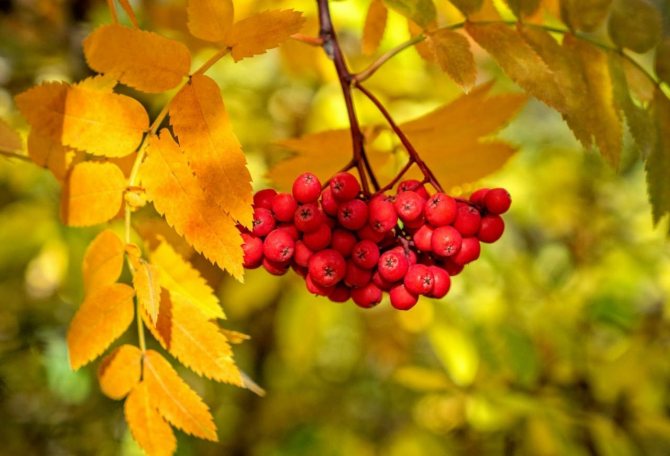

Berries are used to improve well-being with:
- diabetes;
- diseases of the kidneys and liver;
- anemia;
- hemorrhoids;
- diseases of the digestive system;
- ulcers;
- gastritis and colitis.
The history of the emergence of the best recipe for rowan tincture
It turns out that a long time ago all ordinary people in Russia knew well where to look for and collect the highest quality, useful and suitable for all kinds of homemade red rowan - in the Vladimir province, not far from ancient Suzdal. And to be more precise, in the vicinity of the village of Nevezhino.
A certain Arseny Smirnov knew very well about this - the same one whose name, or rather, the last name, was also named for one of the many-sided vodkas in Russia. From this nevezhin mountain ash, he prepared a tincture, which was presented at the Paris World Exhibition at the end of the nineteenth century - back in 1889.The taste, color, aroma and other considered properties of this Russian product amazed the members of the tasting committee so much that the recipe for the Nezhinskaya Rowan tincture was recognized as the best recipe, for which it received the Big Gold Medal.
Here we are going to cook it at home today.
Only two ingredients are berries and an alcoholic base. as such, you can use vodka, moonshine or alcohol. The berries should be strong, whole and, preferably, touched by the first frost. And the alcoholic base just has to be
You also need a container - depending on the appetite of those preparing this tincture according to the best recipe of a suitable volume, a glass vessel or a wooden barrel - in the latter case, the tincture will be almost authentic.
Personal menu
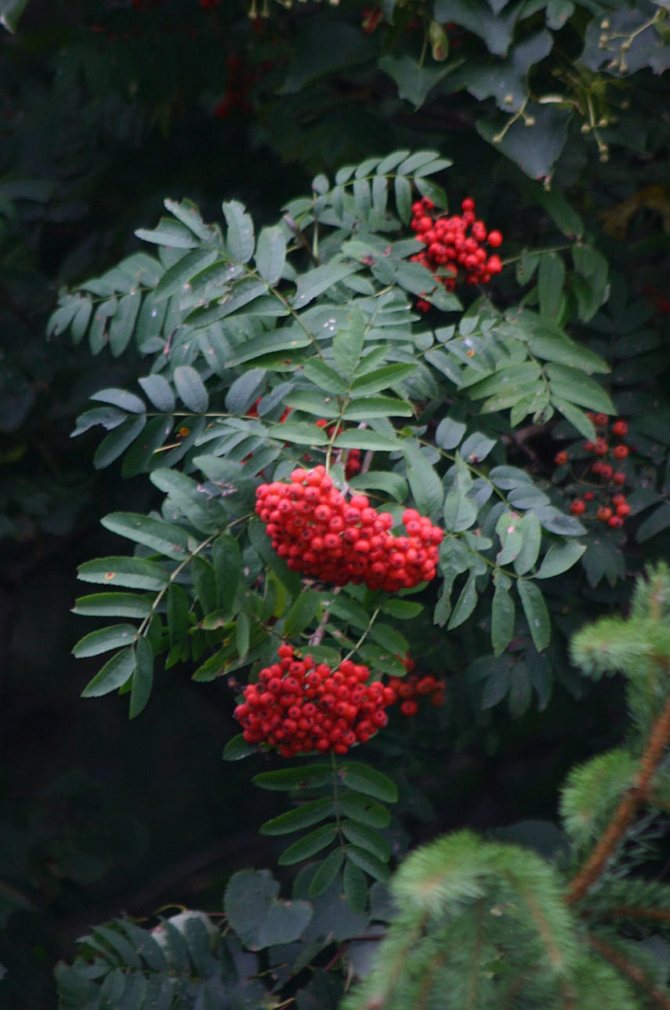

Rowan care is the same as for an orchard: timely watering, feeding and weeding. The plant is very responsive to fertilization.
In the first year after planting, give up organic matter: because of it, the roots grow worse. Then (a year later) feed nitrogen fertilizers in the spring, and in the fall add 40-50 g of superphosphate and 20-30 g of potassium salt under each plant.
Since the roots of mountain ash lie close to the surface of the earth (18-20 cm), the soil around it must be loosened carefully. In addition, deep cultivation causes abundant root growth (especially in the first years after planting), which prevents the tree from growing. Therefore, annually in March, until the buds are swollen, carefully cut off the shoots with a pruner or a sharp knife, without leaving hemp, otherwise new shoots will go from the dormant buds.
Pruning is carried out mainly only sanitary. In vigorous varieties and species from 5-6 years of age, the height is limited to 3-3.5 m, transferring the central conductor to one of the lateral branches, and skeletal branches to lateral semi-skeletal branches. So the crown turns out to be lighter, and the branches do not shade each other.
A planted rowan tree can delight you for half a century. But it actively bears fruit for no more than 25 years.
Common diseases of red rowan
Birds are the biggest enemy for mountain ash fruits. It is very difficult to fight with them, since birds use berries for their feeding, especially in the cold season.
Among other pests, it is worth noting:
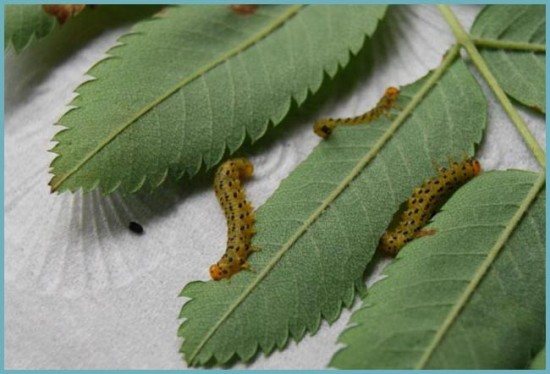

- ticks;
- bark beetles;
- mole, etc.
Although the red mountain ash is practically not susceptible to diseases, it is pests that bring the greatest damage. They can be dealt with both by folk methods and by purchased chemicals.
Plant a red mountain ash on your site, you can check its benefits from personal experience!
Where can I get cuttings?
First of all, ask your neighbors or other correspondence gardeners. If the neighbors refuse you a twig, then you should ask for at least a few buds, and then in August, carry out the inoculation with an eye. If you have not yet learned how to graft plants, then you should do this business, because it is not so difficult. Root shoots of wild mountain ash that grows on your site can be safely used as a stock. In order to do this, it is removed from the mother plant and grafted onto cultivars. Do not forget that it is forbidden to propagate already grafted rowan trees in this way, since it has root shoots from the scion, wild. Rowan is excellent, propagates by cuttings and layering.
How to plant rowan in autumn?
Autumn planting differs from spring planting in many respects. In order for the mountain ash, planted before the onset of cold weather, to take root in a new place and grow well, you must adhere to the time-tested rules.
Selection of seedlings
Before you start planting, you need to purchase a quality seedling.
- The root system should be moist, without visible damage, with 3-4 main branches and a length of 25-30 centimeters.
- The presence of shriveled bark indicates that the planting material has been overdried.
- The crown must also be well developed, the presence of the main conductor and main branches is very important.
Preparing a seedling for planting:
- Before planting, it is necessary to remove all dry and damaged branches, the same rule applies to the roots of the tree.
- For the best moisture, the root system of the seedling is placed in a clay mash for 2-3 hours.
Selecting and preparing a site for planting or replanting a tree
Rowan is famous for its unpretentiousness and the ability to take root on various soils. But in order for the tree to grow and bear fruit better, the following conditions are met:
- The best option would be loamy or sandy loam soil.
- The soil should be loose and neutral; expanded clay drainage is encouraged.
- Rowan is very fond of sunlight, so it is better to choose an area that is not shaded.
- The soil must be well moistened.
- It is desirable that the groundwater level be below 1.5 meters, but mountain ash also tolerates a closer location.
Fertilization and feeding of red mountain ash
To feed mountain ash trees, purchased fertilizers or infusions from dung or mullein are used.
If the finished products do not require preparation, but only adherence to the technology of their introduction into the soil, then a little time needs to be spent on the creation of a biovitamin substance.
Important! Experts recommend feeding the plant in the third year of its life.
Preparation of natural dressing:
- From bird droppings: fresh bird droppings are poured with water, the mixture is kept for 3-4 weeks, stirred well, water is added (ratio 1:10), poured under the root.
- From mullein: cow cakes, as well as bird droppings, are poured with a small amount of water, infused for 3-4 weeks, stirred with water (ratio 1: 5), poured under the root.
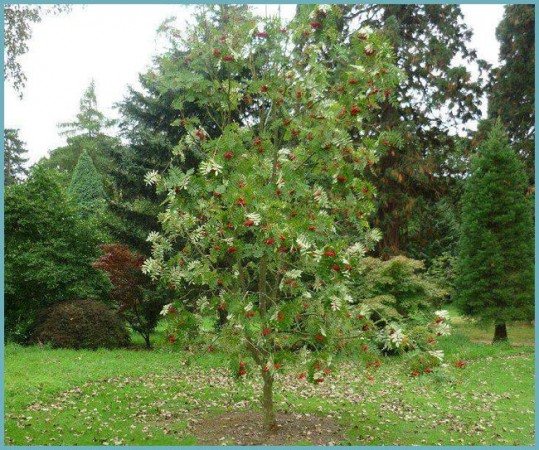

Such vitamin supplements significantly activate the growth and development of mountain ash, they are carried out once a year.
Literature
Wikisource has texts on the topic Sorbus aucuparia
- Rowan // Encyclopedic Dictionary of Brockhaus and Efron: in 86 volumes (82 volumes and 4 additional). - SPb., 1890-1907.
- Gubanov I.A., Kiseleva K.V., Novikov V.S., Tikhomirov V.N.
Illustrated guide to plants of Central Russia. - M .: T-in scientific publications KMK, Institute of technological research, 2003. - T. 2. - P. 410. - ISBN 5-87317-128-9. - Gabrielyan E. Ts.
Mountain ash (Sorbus L.) of Western Asia and the Himalayas. - Yerevan: AN ArmSSR, 1978. - V. A. Zayats
Distribution, biomorphological characteristics and prospects for the use of Sorbus domestica L in the Transcarpathian region // Issues of protection and rational use of flora and fauna of the Ukrainian Carpathians. - Uzhgorod, 1988. - Konovalov V.P.
Genus 16. Rowan - Sorbus // Trees and bushes of the USSR. Wild, cultivated and promising for introduction. / Ed. volumes by S. Ya. Sokolov. - M.-L .: Publishing house of the Academy of Sciences of the USSR, 1954. - T. III. Angiosperms. Families Trochodendronaceae - Rosaceae. - S. 465-468. - 872 p. - 3000 copies. - Kuryanov M.A.
Industrial and biological study of mountain ash, chokeberry and the results of their use in distant hybridization. - Michurinsk: Abstract of the dissertation of the candidate of agricultural sciences, 1973. - Kuryanov M.A.
Rowan is garden. - M .: Agropromizdat, 1986. - Petrov E.M.
Rowan. - M .: Gosselhozizdat, 1957. - Petrova I.P., Sokolova S.M.
Biochemical characteristics of fruits of introduced species of mountain ash in Moscow // Byul. Ch. nerd. garden. - Uzhgorod, 1984. - Issue. 131. - Genus 43. Sorbus L - Rowan // Vegetable resources of the USSR. Flowering plants, their chemical composition, use. Family Hydrangeaceae - Haloragaceae. - L .: Science, 1987.
- Udachina E.G., Gorbunov Yu.N.
Rowan: nutritional value, varieties, new in reproduction, the basics of agricultural technology // Gardening and viticulture. - 1993. - No. 5-6.
Picking berries


Rowan berries will remain on the branches and do not fall off for a long time. From bitter-fruited varieties, berries must be picked after the onset of frost. Then bitterness and astringency will go away from them.
They start harvesting sweet-fruited varieties immediately after ripening so that they are not pecked by birds. The berries are harvested from low-growing plants by hand, and from tall bunches they are cut with pruning shears.
One tree can produce up to 20 kg of berries.

